
Wildlife Photo Diaries 2025
Wildlife Diaries for Norfolk, the UK and Garden
November 2025
Garden Notes 1st-16th......
There seems to be more flowers out in the garden than there was throughout the ‘Spring and Summer’! The relatively mild weather has allowed flowers such as Nasturtiums to continue growing and flowering, whilst the Cosmos are absolutely thriving! There has been new growth throughout the garden and like the yellow Clematis that flowered when it ‘shouldn’t’ there have been flowers on the Honeysuckle and the Sweet Peas are still producing flowers. Just some of the more recent changes in the ‘confines’ of my garden I have witnessed.
You don’t have to be a scientist to see that something is happening to our weather systems and climate worldwide, just look around you! What can you do? Well at the very least make sure your gardens (if you are lucky enough to have one!) attract and provide for the other animals we share our environment with; don’t forget what Sir David said; ‘every square metre count’s. So, if you won’t listen to me, you should at least listen to Mr. Attenborough.
The month (1st) began with a nice selection of birds visiting the garden, which included: 5 Starling, Wood Pigeon, Collared Dove, Robin, House Sparrow, Great Tit, 3 Blackbird, and a Dunnock.
A Wren was in the garden (2nd) searching amongst the foliage for prey, as was a Blue Tit, whilst a Blackbird was dragging weed out of the pond, which I have seen them do many times before to find prey. Maybe this is a relatively recent learnt behaviour, but I have witnessed it from the early 2000’s. Although I have not actually witnessed it maybe they can find access to pond snails, which tend to have softer shells than terrestrial Snails?!
A Wren was again in the garden (8th), along with 2 Blue Tit, Great Tit, 2 Wood Pigeon, 2 Collared Dove, 14 House Sparrow and a Robin.
A Blue Tit was on an apple on the bamboo cane (9th), which is still working very well especially for the Starlings. 10+ House Sparrow, female Blackbird, 2 Wren, Dunnock, 4 Wood Pigeon, 2 Collared Dove and Robin were also present.
The Wrens seem to find the garden a good place to forage for food and one was present again (12th), along with Great Tit and 2 Blue Tit.
Pink-footed Geese have been heard calling as they fly across, just after 06.00 on both 15th and 16th. The sounds of these Geese which went on for several minutes; appears to suggest significant numbers going over.
October 2025
Garden Sightings 17th-31st October
A Wren was again in the garden (17th) along with Dunnock, several House Sparrow, 2 Collared Dove, 3 Wood Pigeon, 5 Starling, 4 Blackbird (2 1st W females, 1st W male and ad male) and 2 of each Blue and Great Tits searching for food amongst the plants and investigating every ‘nook and crannie’. The silhouette of a Heron (presumably Grey) flew over in the early evening and skeins of Pink-footed Geese passed overhead.
A Peacock was on the remaining small Buddleia spikes (18th) and again on 21st.
For the third year running; Apples and Pears were ‘impaled’ on a bamboo cane in the garden. The original thought behind this was to attract overwintering Blackcaps, which they did, but they also attracted, somewhat surprisingly Blue Tit/s! No one (at least locally) I know had seen this Blue Tit feeding behaviour and I still have not heard anything since; but here, once again was a Blue Tit feeding on the apples (18th) put in place in the garden.
Later in October, Starlings were also enjoying the fruits both on the cane and on the ground and an increase in Blackbird numbers also saw Blackbirds feeding on the apples and pears placed on the ground. Blackbirds were also enjoying the berry laden Cotoneaster on the side of the shed.
For the rest of October, it was good to see birds enjoying the garden’s ‘facilities’, with the following species recorded: House Sparrow, Dunnock, Wren Robin, Blackbird, Starling, Blue Tit, Great Tit, Collared Dove and Wood Pigeon.
*Images below taken through the kitchen window, except Pink-feet.


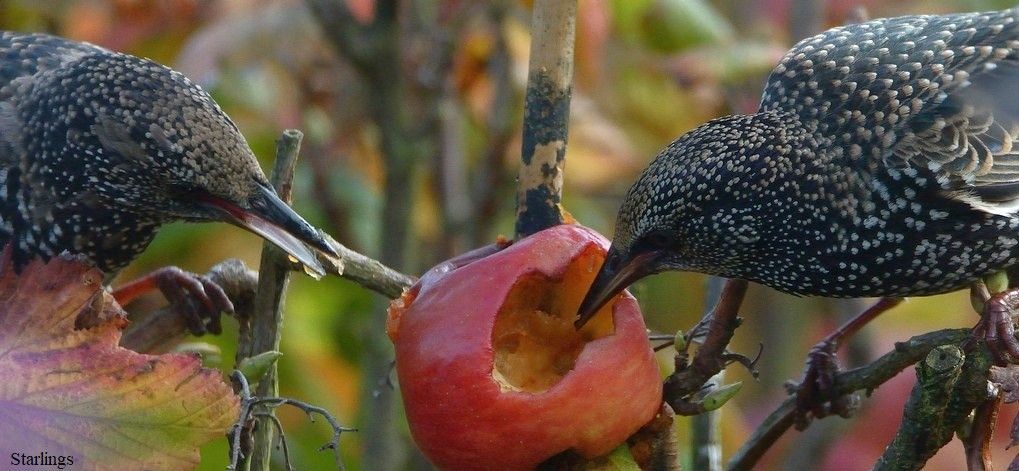
Garden Sightings 1st-14th October
The garden was originally designed to become a ‘Woodland Edge’ habitat and it would seem to have achieved that. Birds are now becoming very interactive with the large tree behind the garden and the few trees and hedgerow (that also exist here) and the garden (wildlife corridor effect).
There are now a good variety of shrubs and trees in the ‘small’ area of garden, which include natives such as Hawthorn, Blackthorn, Hazel, Privet, Willow, Mountain Ash and Dogwood along with wildlife attractant species such as Flowering Currant, Buddleia (B. davadii and B. globosa), Cotoneaster and Pheasants Ear. Climbers such as Clematis, Ivy and Honeysuckle and the wide range of wildlife-friendly flowers all serve to attract wildlife to the garden.
The variety of birds in the garden on the 1st of October were: 3 Blue Tit, Great Tit, Robin, 4 Collared Dove, Wood Pigeon, 2 Wren, 10+ House Sparrow, 2 Starling, 2 Goldfinch, 2 Blackbird, Dunnock and 2 Long-tailed Tit. A Common Buzzard passed over and Pink-footed Geese were heard calling.
A Hobby flew over at speed (2nd) and a Hedgehog was in the garden at 20.50 and again at 21.01.
The most Collared Doves ever seen at one time were in the garden (4th) with 6 individuals.
A cock Pheasant was present (5th) and a Great Spotted Woodpecker (possibly a female) flew over the dwellings.
A Muntjac was on the back grass in the early morning (6th), seen on several occasions and coming close to the garden gate. I think if the gate had been open it would have ventured in! A single Long-tailed Tit was present and later Pink-footed Geese were heard flying over. Just before dusk a Robin-sized bird flitted onto the opposite roofs and under the solar panels. I only got brief views on a couple of occasions but it looked very much like an immature Black Redstart. Later still a Hedgehog came for food and water at 20.20 and again around 20.30 (7th). Great to see this mammal back in the garden on a regular basis.
A ‘small Bat’ species flew past a couple of times at 06.45 (8th) and a Hedgehog was present again at 21.06.
Approximately 50 Starlings were flying around in formation (9th) and it then became apparent why when a female Sparrowhawk landed in the large tree behind the garden. 6 Greenfinch also flew out of the large tree and a Common Darter flew past. A Wren was in the garden.
An Ichneumon species was seen on the outside frame of the kitchen window (10th). This Ichneumon (always difficult to identify) with its black body and orange legs was very striking, but by the time I had got the camera and went outside it had gone. However, according to the Natural History Museum article’s flight times suggested either a Apechthis compunctor or Pimpla rufipes.
At least 12 Long-tailed Tits were in and out of the back large tree and 30+ Pink-footed Geese flew over calling.
A Wren was once again in the garden (14th), 2 Muntjac were barking, in the evening from two different directions and a Hedgehog was seen on several occasions as it came for food and water from 08.05, till just before 21.00. The hog seems to be keeping to just the south of the garden; moving off along the bark path and also appearing out of both borders to resume feeding on the cat biscuits and drinking from the small water bowl.
September 2025
Norfolk Garden Sightings for September......
22 House Sparrows were present (1st) as were 3 Long-tailed Tits briefly. Buff-tailed and Carder Bumblebees were seen and a Common Buzzard flew over and 3 Swallows flew south.
A Hummingbird Hawkmoth visited the Red Valerian in the early evening (2nd) and again (4th) at 19.08, mainly on the purple Buddleia and again later just after 19.30.
A male Common Darter was in the garden (5th), as were both a Small and Large White.
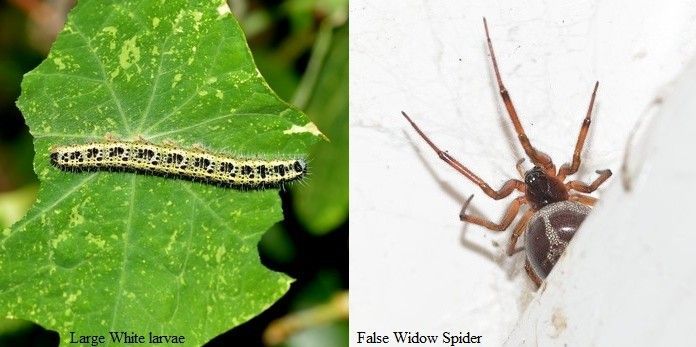
A Hobby flew over (6th) and a Hummingbird Hawkmoth was in the garden at 19.18. A Painted Lady was the first of the year and Peacock, Large and Small Whites also seen.
A Hummingbird Hawkmoth was once again in the garden (7th), Large White (larvae on Nasturtiums), Painted Lady and a Comma also. A female Sparrowhawk flew at a Starling on the feeders but missed and a False Widow Spider (possibly a Steatoda bipunctata) was just outside the shed door frame.
A Tawny Owl was heard calling (8th) at 20.12 somewhere to the south of garden. A Silver Y was in the garden around that time and 2 Large Whites were in garden during the day and a Common Darter perched in the large tree behind garden.
A selection of Butterflies today (9th) with a Painted Lady, Red Admiral, Peacock and 3 Large Whites and a Great Tit took advantage of the Sunflower seed heads left in the garden (10th).
A Hobby was seen (15th) and a cock Pheasant was in the garden (16th).
A female Sparrowhawk was in the skies mobbed by Gulls (18th) and a Hobby was also good to see. Buff-tailed and Carder Bumblebees were visiting various garden flowers, including: Nasturtium, Yellow-lantern Clematis (unseasonally in flower!) and Borage. A male Southern Hawker flew over garden, as did a Swallow and a Tawny Owl was heard again distantly at 19.45.
Painted Lady, Peacock and Large White were seen (19th) and a Common Darter was at the front of the property on the wall, whilst a Migrant Hawker flew past the back garden and a Hedgehog was seen several times between 20.30 and 22.00. Appearing again near the shed was a False Widow Spider, this time; possibly Steatoda nobilis.

A Peacock was in the garden (20th).
The first Pink-footed Geese of the Autumn were seen flying over heading both south and east (24th) from 16.30 with a total of 278+/- from 16 skeins of varying sizes (3-57). A Hobby was also seen and a Hedgehog came in from the garden gate at 20.58 but took no food (cat biscuits) but did drink at length from the bowl of water.
A nice mixed flock of birds, containing Coal Tit, 2 Great Tit, Blue Tit and a Chiffchaff all using the pond came through the garden (26th) and a Tawny Owl was heard calling again in the evening.

A Hummingbird Hawkmoth was in the garden (27th), a Tawny Owl was calling again at 19.20 and a different Hedgehog to the previous sightings came for food.
2 Long-tailed Tit, 2 Blue Tit and a Great Tit once again taking seeds from the Sunflower heads were good to have in the garden (28th).

13 Long-tailed Tits flew over with one landing in the garden but then joined the rest of the flock in the back tree before moving on again. A Small White was seen and a Hedgehog (looked like the first one seen during September) made three visits 20.13 onwards.
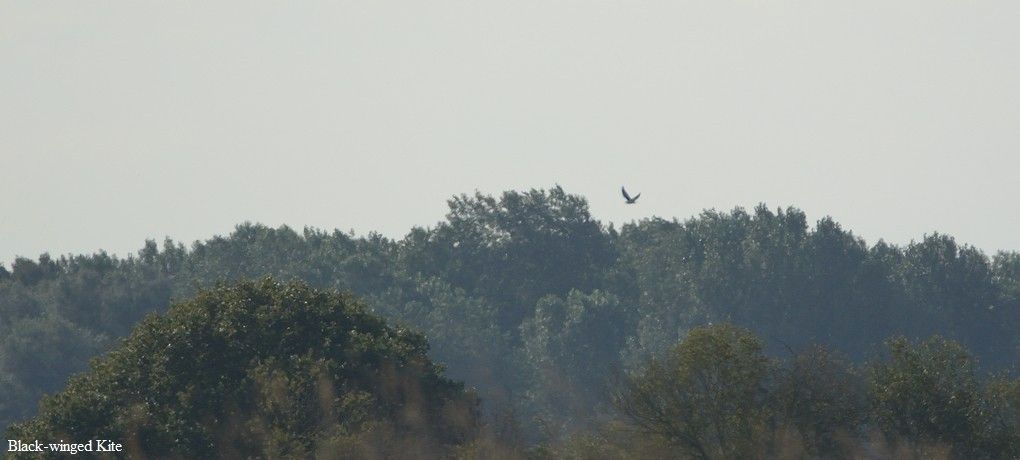
Black-winged Kite at Hickling!
A Black-winged Kite had been found at Hickling and had apparently been there since Friday 5th Sept. Although it had been reported over the weekend, today (9th) was the first chance for Jason Nichols and I to go and have a look.
We arrived at Hickling reserve car park around 08.00 and proceeded to walk along the track beside the marsh, where the kite had been frequenting; mainly perching in the line of dead trees in the distance, where we used to look for Hobby and the occasional Red-footed Falcon.
After seeing Great White and Little Egrets perching in a nearer line of dead trees we began scanning the area from a raised viewpoint, but not going to the one further along where everyone had been told to go!
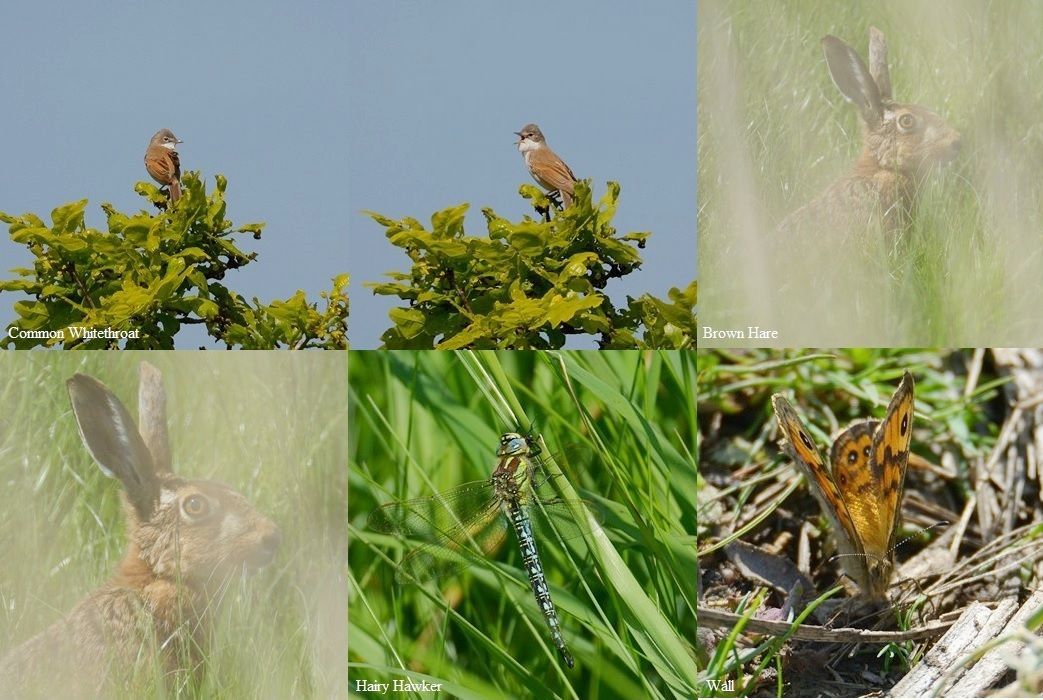
There was no sign of the kite and there were no reports from Jason’s Bird Guides alert but there was plenty of birds to watch, as we kept a lookout for the kite.
Great White (approximately 9) and Little Egrets were flying up and landing again out of sight in the tall grasses and reeds as were Grey Herons and Cranes were constantly calling from somewhere behind us near Stubb Road.
The area had been developed and managed for Bitterns and after its initial excavation, succession had continued to take place and was turning into the prescribed plan; wet-based reedbed (and further on dry-based reedbed) and not the ‘scrape’ type area, which had initially attracted waders and many other birds, viewable and liked by the birding/birdwatching/twitching ‘tribes’! Whether or not work will continue to manage a suitable Bittern habitat, like how the area was managed for hundreds of years before (‘The Great Swamp’) is debateable, as my experience with the management at Hickling tells me no further work will be done due to lack of funding for designated species like the Bittern.
Spoonbills were then seen; again, when they flew up and for a while there was 2 adults and a juvenile seen, but later in the morning a flock of 8 were seen in flight together. A Hobby flew across and Greenshank were heard and a brief view of a calling Green Sandpiper, whilst several Common Snipe dropped down into the marsh.
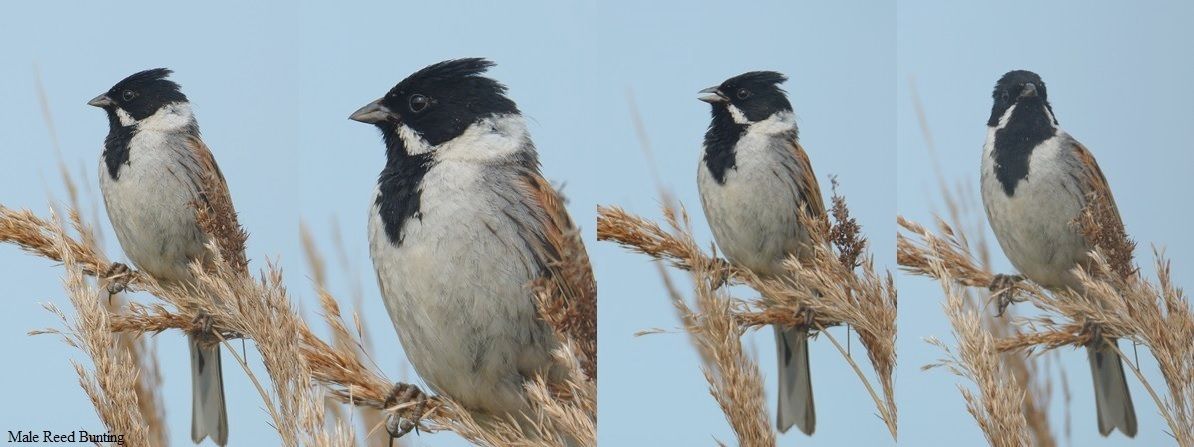
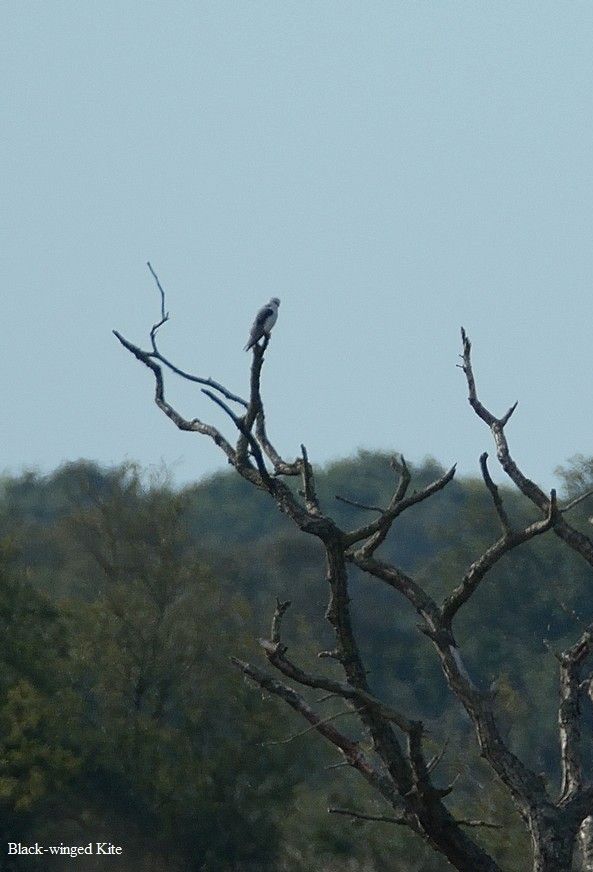
Time went by with a steady trickle of people arriving and heading further along the track and several false alarms of heat-haze silhouettes of birds in the distant dead trees, which turned out to be mainly Crows and Wood Pigeons and also inanimate objects!
Two, probably a pair of Cranes flew across the sky our first actual view since the audio evidence of their presence and a pair of Marsh Harriers were over the far reeds.
A conversation with Phil Heath, who had obviously been keeping a watch on the Black-winged Kite during its stay said it tended to appear once the sun had warmed up the area and therefore the insects, particularly Dragonflies on which it had been preying on as well as two small Rodents caught at Heigham Holmes, Phil said. So, there was still hope that the kite was still here and would show up again.
Just before 09.00 I saw a bird fly in and land on one of the top branches of the line of dead trees; it was the kite and unbeknown to us someone we had just been talking too was a short distance from us and we heard him call out; ‘bird’! He had spotted it too.
However, shortly after landing the kite was seen off by a crow but then flew along the line of trees and landed lower down on a branch, but once again it wasn’t there long and then flying off, back along the trees and out of our sight, which was obscured by Gorse.
A little later I spotted a bird perched in a small tree, A little later I spotted a bird perched in a small tree, again in the distance and in increased heat-haze. Jason had a look through his scope and suggested it was a bird of prey but couldn’t see much more than a silhouette. Jason then walked a little further along the path and came back to say people were intently watching something, so we walked further on. Speaking to the gentleman who had called out ‘bird’ earlier (he asked if we had heard him) he could indeed see it and invited me to have a look through his scope and yes there it was. I then had to locate it through my bins, which took a little while, but when I did locate it, it appeared if I walked further up to the flood bank it would be the closest, we had gotten to it. Sure, enough it was; still distant but better than before-when I had done my best to get images of it in the trees and in flight (as it turned out later too far away and in terrible light!). This time however, the bird remained perched and I took some more images before we left the kite to go back to the car park; Jason's work video call imminent.
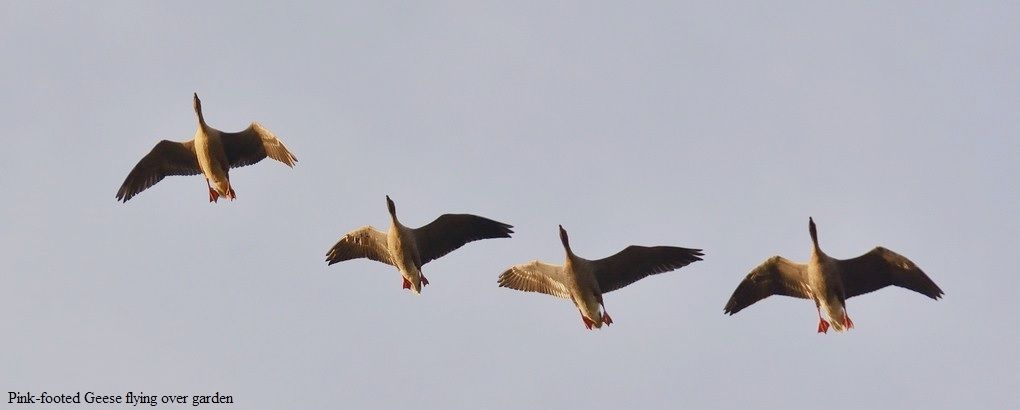
Just before we left approximately 18 Cranes flew out from where they were and then disappeared behind the trees. Walking back, I saw something in the grass; it was a Great Silver Water Beetle Hydrophilus piceus (or as I grew up knowing it; Great Silver Diving Beetle) making its way across the path. I had seen this before at Hickling dead near a light trap and as a larva, identified one from a photo sent to me and going well back in time; one I caught at the end of a dyke behind where I lived when I was a small boy only on that occasion the air bubbles on the underside of its body showing how it got its name!
Several Migrant Hawkers were on the wing and a Red Admiral had been seen as was a smallish ‘brown’ butterfly I could only guess would probably be a Wall. Just before the car park, another pair of Cranes flew over ending a very enjoyable morning’s nature-watching.
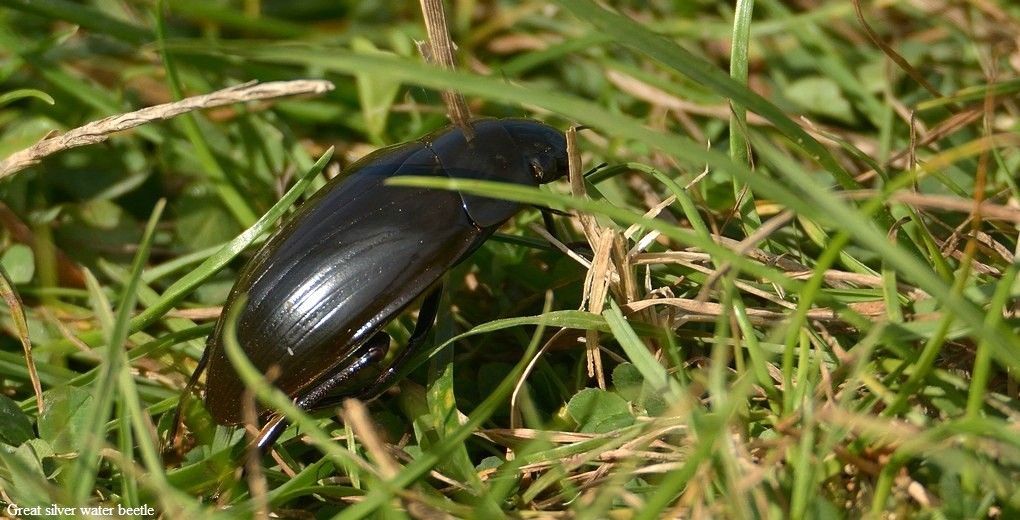
August 2025
'Hummies' regular in the garden and first Hedgehogs for a very long time!
The second half of August began (15th) with Holly Blue, Large and Small White and a Hummingbird Hawkmoth at 19.52. A Darter species, probably a Common flew over.
A Sparrowhawk was perched on the garden gate, whilst I was sitting out there (16th), obviously not spotting me!
5 Blue Tit, Great Tit and a Robin were of note (17th).
5 Long-tailed Tits and 4 Blue Tits were good to see (18th). A Small White was also present and a Hummingbird Hawkmoth graced the garden once again at 17.30.
A Wren was present (19th) and a Hummingbird Hawkmoth again (20th).
A male Blackcap was good to see (22nd), as were 2 juvenile Wren, 7 juvenile Long-tailed Tit, 4 juvenile Blue Tit and 3 Great Tit (1 juvenile). Also seen were 3 Dunnock, Robin and 4 House Sparrow; a good avian day in the garden.
6 Blue Tit and 2 Great Tit were coming to the feeding station and for water (23rd). A Hummingbird Hawkmoth made 3 brief visits, during the early evening and a Common Buzzard flew past. The highlight of the day was when a small Hedgehog (hoglet) appeared in the border at 21.30 before climbing over the border boundary and disappearing along the path.
2 Small Whites were present (24th) mainly around the Nasturtiums and Long-tailed Tit, 5 Blue Tit, 2 Great Tit, and Wren were also seen. An Orange Swift was found on the kitchen window ledge and a Small Dusty Wave (Thanks to Ken Saul for identification) on the wall in the bathroom. Both moths were caught and put back out in the garden. A responsibility we all have as otherwise they will die indoors. Another fast-declining group of species; when was the last time you had a squashed moth on your car windscreen?!
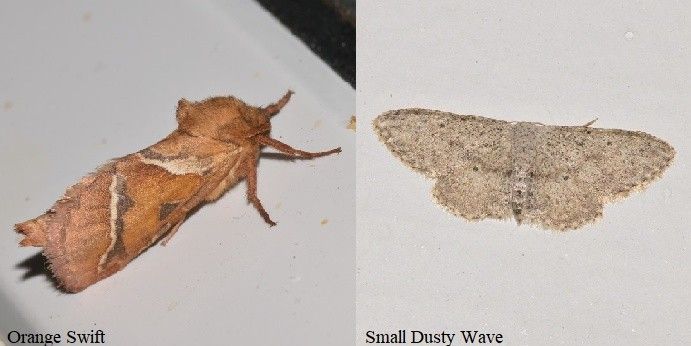
What looked like the first Migrant Hawker of the year flew over (25th), a Common Darter was in the garden, as were both Large and Small Whites. 2 adult Mediterranean Gulls flew over.
An uncommon species; almost rare here was seen (26th) calling from the top of the large tree behind the garden-a Chaffinch!
In the garden were: Wren, Large White, Small White, Red Admiral, Hummingbird Hawkmoth 18.35, and a Migrant Hawker flew over, as did several House Martins. A hoglet was seen again in the same place at 21.08.
A Painted Lady was the first of the year here (27th), along with Peacock and 3 Small White.
Both Small and Large White were around the Nasturtiums again (28th) and a Hummingbird Hawkmoth was visiting the ‘Hot Lips’ at 19.19. A Common Buzzard, Swallow and a total of 10 House Martins flew over.
Biting Fly identified, high count of Med Gulls and Swallowtail next-door!
August began with 7 juvenile Blue and one Great Tit in the garden (1st). Also present were: adult Robin, 14 Starling, 6+ House Sparrow, male Pheasant, 3 Collared Dove, Wood Pigeon, Dunnock, Jackdaw and Pied Wagtail (on roof) and a Goldfinch. A single Swift remains.
4 Swift, with 10 later were seen (2nd) possibly on passage as were 3 House Martins.
A juvenile Pied Wagtail was being fed by adult female on the grass outside the back
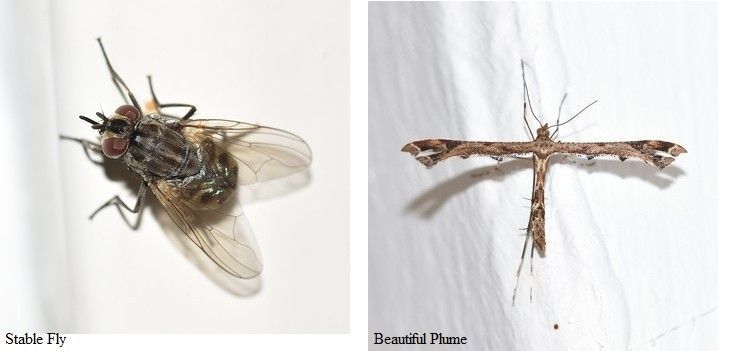

garden (3rd). A Dunnock in moult, a juvenile Wood Pigeon and a cock Pheasant (now minus its tail) were in the garden.
Both a juvenile and adult Robin were present (4th) and a male Southern Hawker flew over at 21.08. A single Swift and 3 House Martins were overhead.
Despite a breezy day (5th) saw a Holly Blue and a Small White in the garden. Meanwhile indoors an Amblyptilia acanthadactyla Beautiful Plume was found in the bathroom and the species of small fly that keeps biting me was identified as a Stable Fly Stomoxys calcitrans!
Large White, 2 Small White and a Peacock were seen (6th) and a ‘yellowish’ Warbler, possibly a juvenile Willow Warbler was briefly in the garden; too briefly to add it to the garden list!
Dispersing Ants were in the sights of a flock of Gulls in the skies containing Mediterranean Gulls and 4 House Martin, 3 Sand Martin and 2-3 Swift flew over.
A Wren was in the garden (7th) and again the following day (8th) when 37 Mediterranean Gulls were moving south overhead in a steady stream.
A Hummingbird Hawkmoth flew through the garden in the late afternoon.
Large White, 2 Small White and a Gatekeeper were present (9th), as was a Wren again.
An Orange-vented Mason Bee was seen going in the main bee hotel and Mediterranean Gulls were once again in the skies with Flying Ants were seen emerging from a neighbour’s garden at (No 1) where a Common Darter was also seen.
A ‘large’ female Sparrowhawk flew over the garden (10th) and the highest concentration of Mediterranean Gulls I have ever seen anywhere were overhead with at least 100 in the skies. Of interest; Ken Saul told me that 90 had been recorded in a WeBS count on Filby Broad that day.

The first Common Darter in the garden appeared, perching on top of the feeding station pole (11th).
A male Brimstone visited the Verbena flowers and 2 Small White and a Gatekeeper were also present. A single Long-tailed Tit came to the feeding station along with 3 Blue and a Great Tit and a Wren was a welcome visitor again along with the tail-less cock Pheasant and a Common Buzzard flew over.
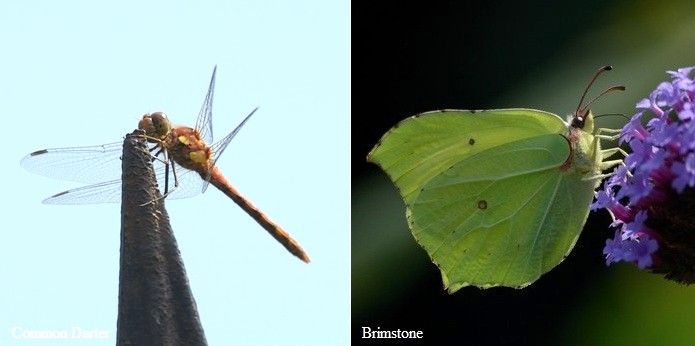
A surprise visitor to the area came 16.25 (14th) when a 2nd brood Swallowtail was seen on next door’s (5) Buddleia davadii. Photos were taken before it moved off S.E. Unfortunately, it did not visit my garden, but great to see nevertheless and after all I have a record of a Swallowtail in the garden (also on Buddleia and additionally Catmint), several years ago not long after I moved here.
A Common Darter was again on its favourite perch (feeding station pole), using it as a base for hawking for passing insects. Small and Large Whites were still here and a male Southern Hawker did a fly-over again in the late afternoon and at least one Mediterranean Gull was in the sky.
At least 2 Megachile centuncularis Patchwork Leafcutter Bee were entering the bee hotel and there was evidence that a Leafcutter sp. had been using it before with a leaf piece in a chamber.
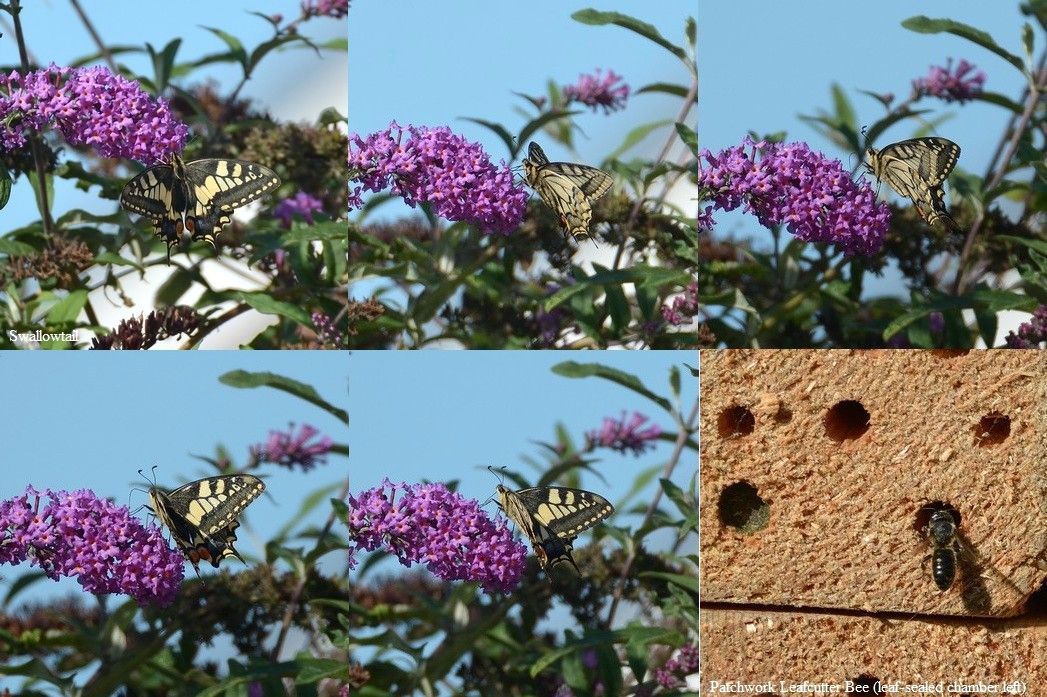
July 2025
July ends with Chiffchaff and Hummingbird Hawkmoth......
The last few days of July had a Comma, 2 Gatekeeper, Peacock and Large White present (27th). A Wren and 2 juvenile Robins were in the garden and a Mediterranean Gull flew over.
A Chiffchaff was in the garden (28th) followed by a Hummingbird Hawkmoth present (29th). Also seen on the 29th were; Red Admiral, Peacock, Comma, 2 Gatekeeper and both Large and Small Whites.
5 juvenile Blue Tits were coming to the feeding station (30th) as was a juvenile Great Tit. 2 Swift remain in the skies.
A single Swift was seen (31st) and a Common Buzzard flew over.
Wildlife Garden Diary 10th-24th; Wall sightings and new Wasp sp. for garden......
A nice selection of Butterflies started the second weekly period of July (10th) with Comma, Small Tortoiseshell, Peacock, Holly Blue, Large, Small and Green-veined White all present, albeit in very small numbers. A Pied Hoverfly was also present and Orange-vented Mason Bees continue to enter the bee hotel. 2 Mediterranean Gulls were overhead as were 9 Swift and a House Martin.
Flying Ants dominated proceedings this afternoon (11th) with hundreds emerging from somewhere next to where I was sitting in the garden. It was therefore not surprising to see numbers of Gulls overhead (Mediterranean, Black-headed and Lesser Black-backed), obviously feeding on these emergent, one of which I rescued from my Cider! Below the Gulls a Hobby was seen flying through but it returned and circled around over the area decreasing in height until it was right over the garden; possibly, also feeding on the Hymenoptera bonanza?
A cock Pheasant was in the garden, which has become a fairly regular occurrence and 7 Swift and 4 Swallow were in the skies, whilst Gatekeeper, Peacock and Large and Small Whites were present in the garden.
Somewhat of a surprise this morning (14th) was when I looked out of the kitchen window to see a Hummingbird Hawkmoth on the Verbena flowers at 5.30! A Wall was new in and there was also 3 Peacock and Small White. A False Widow Spider was in the kitchen and Silver Y’s were seen as darkness approached. 7+ Swift were overhead and a Red Kite drifted over.
Juvenile Blue Tits (2) and a single Long-tailed Tit visited the garden today (16th). 2 Gatekeeper, Peacock, Small White and a Comma were seen again.
The cock Pheasant was once again in the garden (18th) and Red Admiral, Peacock and Small and Large White also.

A Wall was again present (19th) the most sightings successionally I have recorded in the garden. A Peacock and a Red Admiral were also good to see. 12+ Long-tailed Tits moved through along with several Blue Tits, a Swallow flew over and birds of prey featured a Hobby again and a Red Kite. Gulls were once again feeding on flying ants and 8 Swift were in the skies too. Whilst sitting in the garden I noticed one or two Wasp species on the Fennel flowers so I went and got the macro set-up and photographed them. Later I looked at the images and was fairly sure I had identified them, but I consulted Dr. Nick Owens and found out I was close but not close enough. Nick suggested they were Ectemnius continuus aka Dark Fly Fox and on his advice looking at Flickr (Steven Falk) I think he was right! Anyway, this was a new species for the garden. So, I was very pleased and pleased for my persistence in cross-referencing.

Once again sitting out in the garden, behind the pond (21st) it was nice to see a Wall land on a Water Lily bud-but no camera handy! Large White, Small Tortoiseshell, Gatekeeper were also seen along with the micro moth; Small Purple and Gold.
2 juvenile Jackdaws were around the bird bath and 6 Swift and 2 House Martin were overhead.
4 juvenile Blackbirds were present together in the garden (23rd), as was a juvenile Wren which bathed in the pond. A juvenile Robin was seen later; the garden seems to be a good refuge for juvenile Robins over the years (as long as the cats are kept out!) and 2 Small Tortoiseshell and a Large White were also seen.
A Wall was again present (24th) along with Gatekeeper, Large and Small Whites, Peacock, Small Tortoiseshell and a Small Purple and Gold seen again.
Hoverflies and 7-spot Ladybirds were all over the Fennel flowers; a good source for insects presently and for some time. A male Southern Hawker flew over the garden but returned again and looked to be wanting to perch up in the garden but thought better of it! A single Swift remains; at least for now!
Spoonbill feeding behaviour at Cley and insects at Warham......
Spoonbills were a good start at Cley with Jason Nichols (17th) with 8 present from the middle hides and as usual the juveniles chasing an adult bird for food. Actually, it does make one wonder if this behaviour is purely with the adult Spoonbills own offspring or whether it is innate behaviour, where an adult potentially available for food is a target for any juveniles present!
4+ Little Egrets were also here and Cattle Egrets were occasionally seen when they flew up from the herd of cattle obscured by the reeds. A Grey Heron was present and a Whimbrel heard and then seen flying across was good to see. Other waders here were: Green and Wood Sandpiper, Greenshank, several Black-tailed Godwit, several Avocet, 6+ Ruff, 3 Little Ringed Plover, 2 Oystercatcher and several Redshank. A Swallow was singing from the fence outside the hide.
Insects seen, mainly from the paths and boardwalk were: Short-winged Conehead, Black-tailed Skimmer, Brown Hawker and Ruddy Darter.
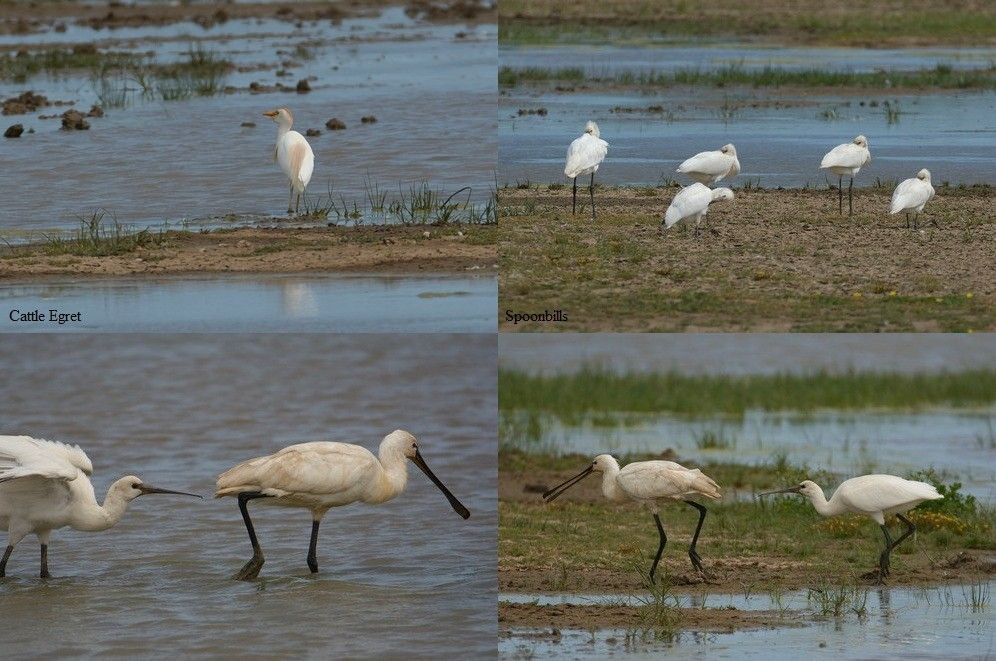

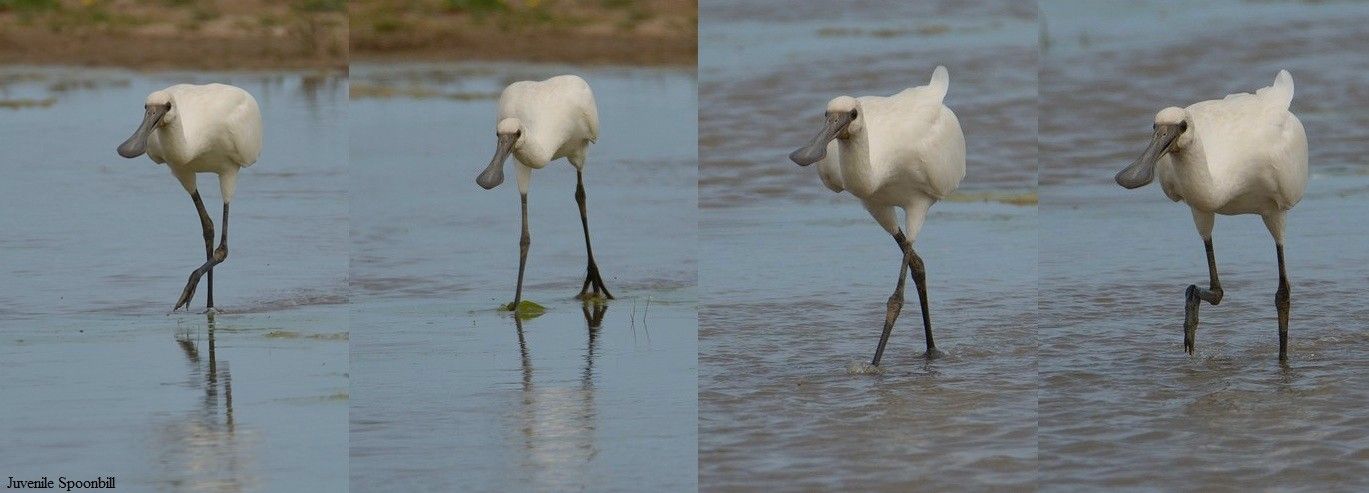


A visit to Warham Camp, in somewhat overcast, breezy, but warm conditions found only a few Chalkhill Blues on the wing and other Butterflies seen were Gatekeeper, Holly Blue, Meadow Brown and Wall. There were plenty of 6-spot Burnets around and two were on the same stem as one emerging. Ken Saul says that:
‘Six-spot Burnet males seem to sense (presumably via pheromones) when a female moth is about to emerge so they come in to mate with her almost as soon as she has hatched and dried her wings. I think there are a few other moth species where this behaviour is recognised too.’
Several Hoverflies were around including Long Hoverflies and several Bees including: Andrena denticulata Grey-banded Mining Bee, A. dorsata Short-fringed Mining Bee, A. minutula Common Mini-miner and possibly Lasioglossum leucozonium dropped paralysed by a wasp which if Bee ID is correct would be Cerceris rybyensis. Thanks to Dr. Nick Owens for his input on the Bees and Wasp.
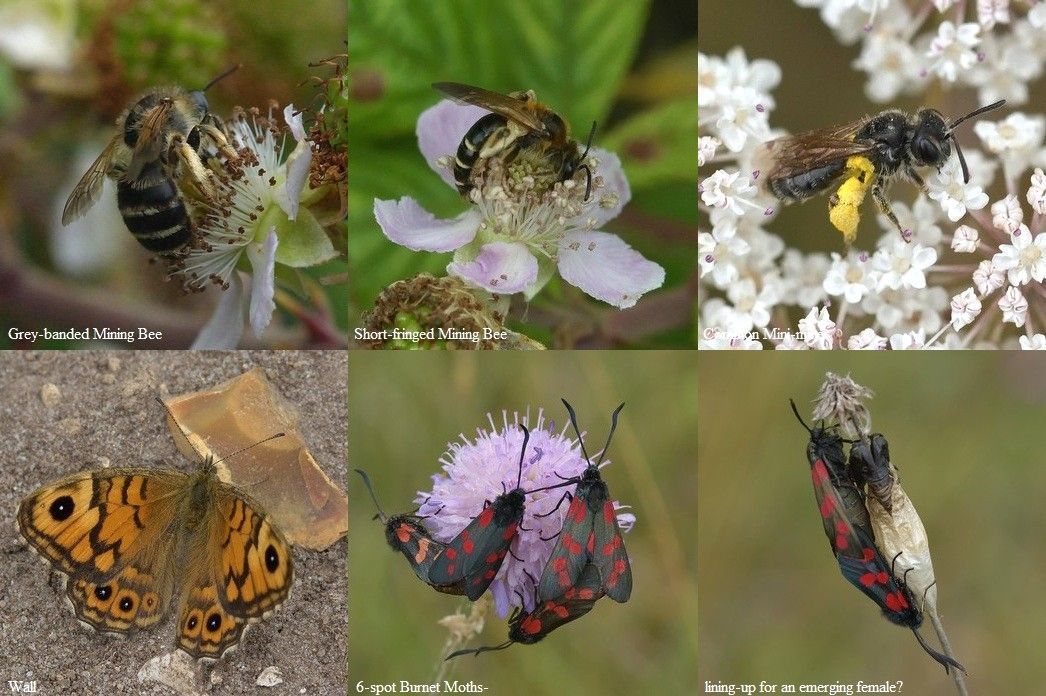
Egrets and Insects......
The day (10th) with Jason Nichols began in the east hide at Cley, where there were at least 10 Black-tailed Godwits fairly close. However, this did not last long when a Marsh Harrier flew over the scrape, just in front of the hide.
Further scrutiny of the area found 3 Cattle Egrets and a Little Egret, plus 2 Green Sandpiper, Greenshank, 4 Ruff, Little Ringed Plover, several Avocet and two Mediterranean Gulls.
As time went on more Egrets arrived until there were at least 23 Cattle and about 8 Little Egrets.

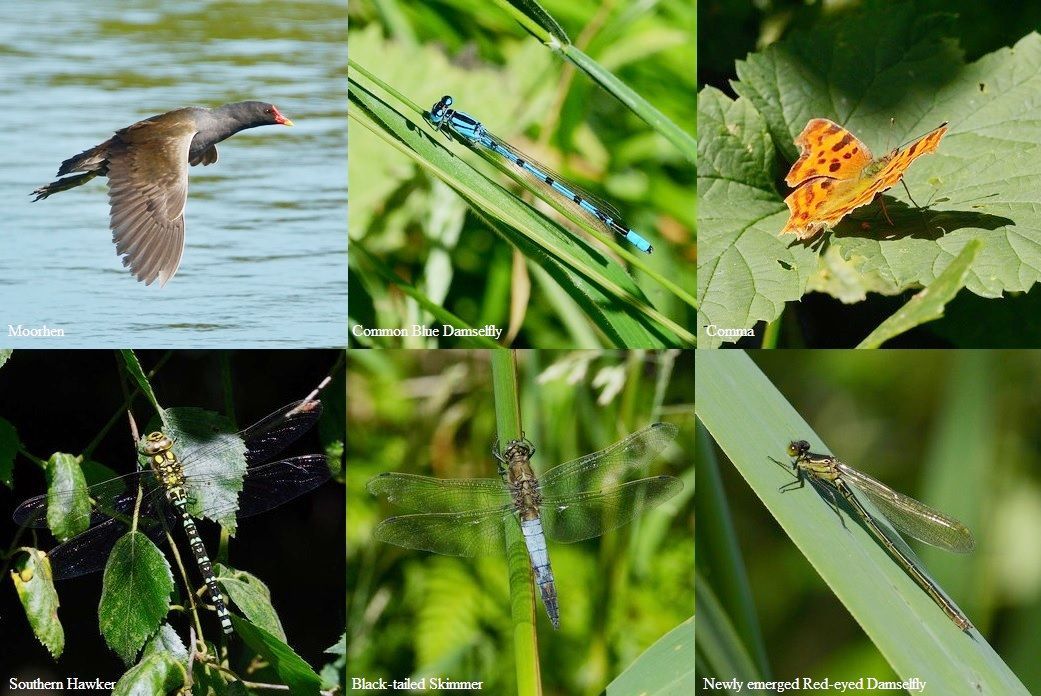
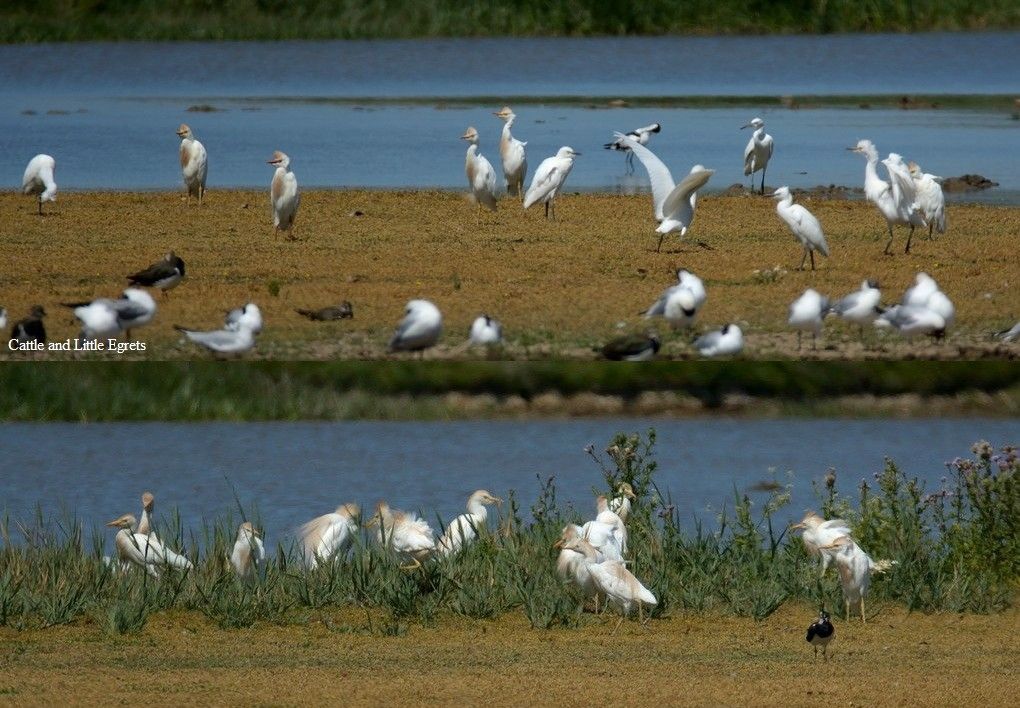
A visit to Weybourne Cliffs followed and we found several Eriothrix rufomaculata Red-sided Parasite Fly on the Ragwort flowers.
At least 6 Bee Wolf Philanthus triangulum were present along with Silvery Leafcutter Bees Megachile leachella and Lasioglossum leucozonium White-zoned Furrow Bee.
Good numbers of 6-spot Burnet moths were on the Ragwort and quite a few Gatekeepers were on the cliff tops, as was a Small Skipper.

Garden Diary 1st-9th July......
3 Small White and a Comma began July (1st) and there were 4 Swifts overhead.
A Peacock and a Large White were in the garden (4th), as was a Dunnock and a juvenile Robin, already with an orangey-flush to its breast. A Red Kite flew over low, barely above the mature tree outside the garden and at least 11 Swift were present.
Five species of Butterflies visited the garden (5th) with a Red Admiral, Peacock, Comma and Large and Small Whites. A Pied Hoverfly was once again in the garden.
Peacock, Large White and Small White were in the garden (8th) and 4 Swift were overhead.
The Buddleia flower spikes are beginning to flower (9th) and have already been visited by Hoverflies and a few butterflies.
Marmalade Hoverflies are everywhere in the garden especially on the Fennel flowers and Comma, Peacock and both Large and Small Whites were present. At least 7 Swift are still present in the skies.
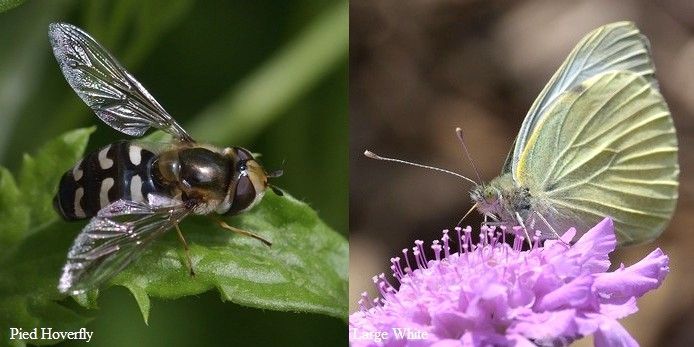
Butterflies and insects at Holt CP......
The first fieldtrip of July (3rd) with Jason began with a look at Salthouse and Cley Coastguards but very little was on offer here on a very hot day again.
We decided to visit Holt Country Park and look for insects, so after paying the £2.50 parking fee we went for a ‘wander’.
The ride nearest the road found our first Silver-washed Fritillaries of the year, along with Ringlets, Large, Small and Green-veined Whites, Meadow Brown and Comma.
The rides up to the pond found much of the same, but near the pond an immature Speckled Bush Cricket was found along with a Sicus ferrugineus a Conopid Fly, which deposit an egg in a flying Bumblebee!
Dragonflies here were several Four-spotted Chasers and Azure and Large Red Damselflies and a Common Lizard crossed the grass.
Heading back towards the car park; two White Admiral were seen but immediately headed for the tree canopy.
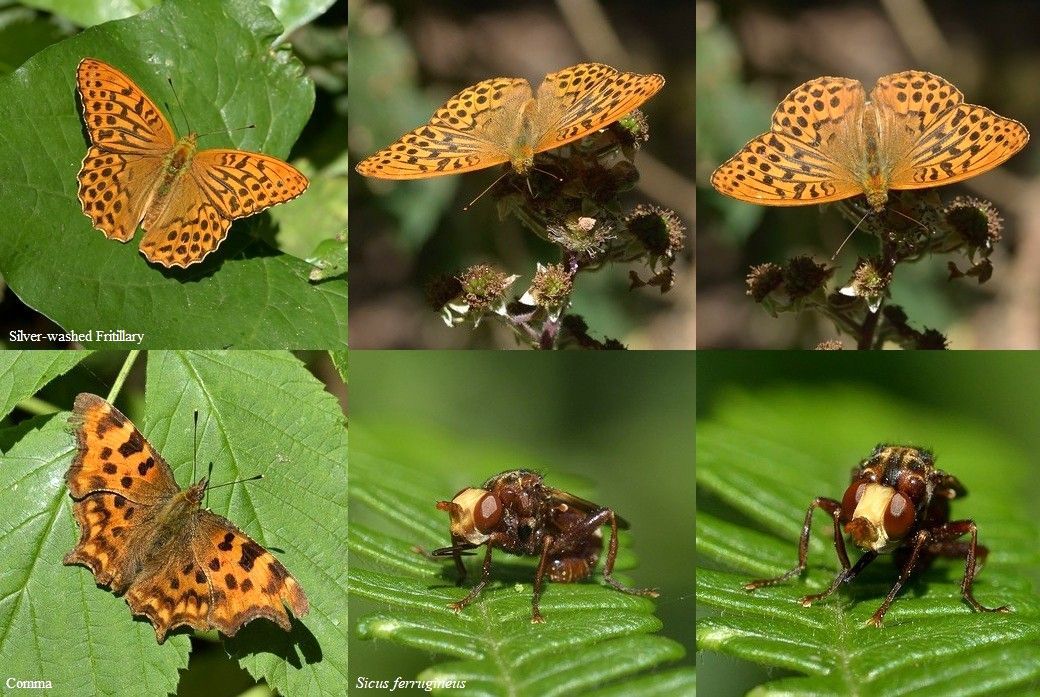
June 2025
Garden Diary (14th-30th) with multiple late afternoon/evening visits from Hummingbird Hawkmoths......
With the first half of June spent overseas, the first observations in the garden were a Long Hoverfly Sphaerophoria scripta and a Pied Hoverfly Scaeva pyrastri (14th).
A Common Buzzard was overhead (16th) as were 5 Swift and 3 juvenile Great Tits were in the garden.
A red Kite was in the skies (18th), whilst an Orange-vented Mason Bee and a Large White were present.
A ‘Batman’ Hoverfly S. silentis was present (19th) along with a Small Purple and Gold micro moth, Large White and Carder, Early, Tree and a queen Garden Bumblebee (visiting Nasturtiums). 7 Swifts were overhead.
A Red Admiral and a Comma were good to see fleetingly in the garden (21st), 2 Small Whites were also investigating the Nasturtiums for ovipositing and a pair of Goldfinches were feeding on ornamental Thistle seeds.
Some of the Buddleia bushes are not fairing too well due to a major assault by Aphids! However we will see what happens with respect to flowering as this is not life-threatening to the plant.
A Hummingbird Hawkmoth was also great to see, briefly feeding on the Red Valerian flowers and 10 Swifts flew in formation together.
A Common Buzzard was again in the skies (22nd) but impressively there were at least 40 Swift over the garden, presumably focussing on a good feeding spot. The following day (24th) there were at least 60 Swift in the skies; a magnificent sight and the most I have ever seen here!
1-2 Juvenile Robins were in the garden (25th) and Comma and Small White also. Just 3 Swift were present today, but 2 Mute Swans flew over; not a common sight here. There were two visits by a Hummingbird Hawkmoth; the first at 17.53 as it started to rain and again at 20.57 when it fed and on Red Valerian and other flowers too.
A Red Kite was seen both in the morning and in the early evening and Swift numbers had risen again to 20+. A Large White was seen and what looked like a Holly Blue very briefly.
Large White, Small White and a Comma were all seen (27th). A juvenile Robin was here again and a juvenile Goldfinch came in for a drink. A Hummingbird Hawkmoth appeared again and again late at 19.54.
A Red Kite was seen again (28th) as was a juvenile Robin and a Small White. A cock Pheasant was in the garden as was a juvenile Goldfinch. 4 Swift were seen and a Ruddy Darter around the pond, before flying out of the garden was the first Odonata this year.
A Hummingbird Hawkmoth was seen again today (29th) at 18.06 and again at 20.42.
A Small White was present along with a Large White ovipositing on Nasturtium leaves. Both an adult and a juvenile Goldfinch came in to drink and at least 10 Swift were in the skies.
A Meadow Brown (30th) was a first for the year in the garden and 2 Small White and a Comma were also seen on what was apparently the hottest day of the year so far; temperatures exceeding 30 degrees C.
An Orange-vented Mason Bee was seen entering the bee hotel and also on a Sunflower. Later, a Silver Y moth was in the garden and the first Summer Chafers were seen, with at least 4 flying around the large tree outside the back of the garden.
A brief hint of Marsh Warbler and 'white birds'......
With the first half of the month back looking for the ‘Big 5’, ‘Small 5’, ‘Ugly 5’ and ‘Green 5’ it was back to a day out with Jason Nichols in Norfolk (19th)!
The day began looking and indeed listening for a Marsh Warbler, near the East Bank, car park at Cley and a few bursts of part-song were heard but no visual. Grey Heron and Little Egrets flew over here, heading for the Heronry in the wood, both Cetti’s and Sedge Warbler were singing here and a fading female Black-tailed Skimmer and 2 Commas were also seen.
A visit to the east hide on the reserve at Cley found 4 Spoonbill, 2 Great White Egret, 2 Little Egret, 3 Green Sandpiper, 8+ Black-tailed Godwit, 2 Avocet and a Little Ringed Plover. Black-tailed Skimmers and a male Emperor Dragonfly were seen, whilst Swallows perched just outside the hide and Peacock, Small Tortoiseshell and Large White were encountered away from the hide.
From Cley Coastguards a Sandwich Tern was seen and 7 Mediterranean Gulls perched initially on the sea, moved off east.
2 Red Kites and a Stock Dove perched on a fence post at Wells Pools, whilst a stop for dinner at Brancaster Staithe just had Homo sapiens!
A Great White Egret was seen flying over Burnham Overy Marshes and the first 2 Meadow Browns of the year were seen near ‘the gate’ at Holkham.
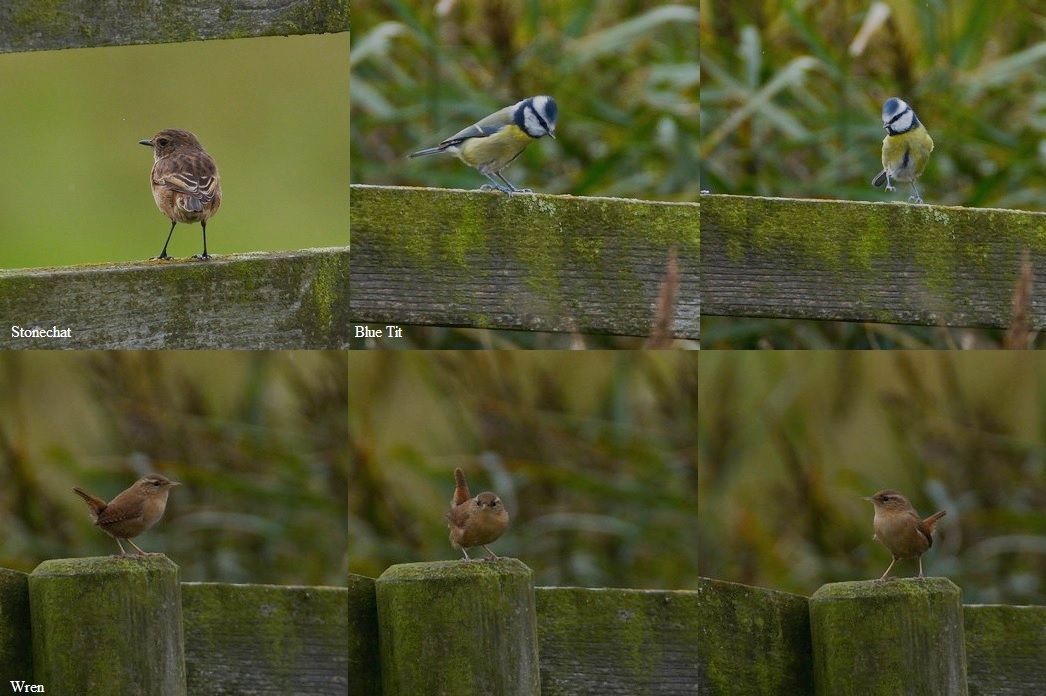
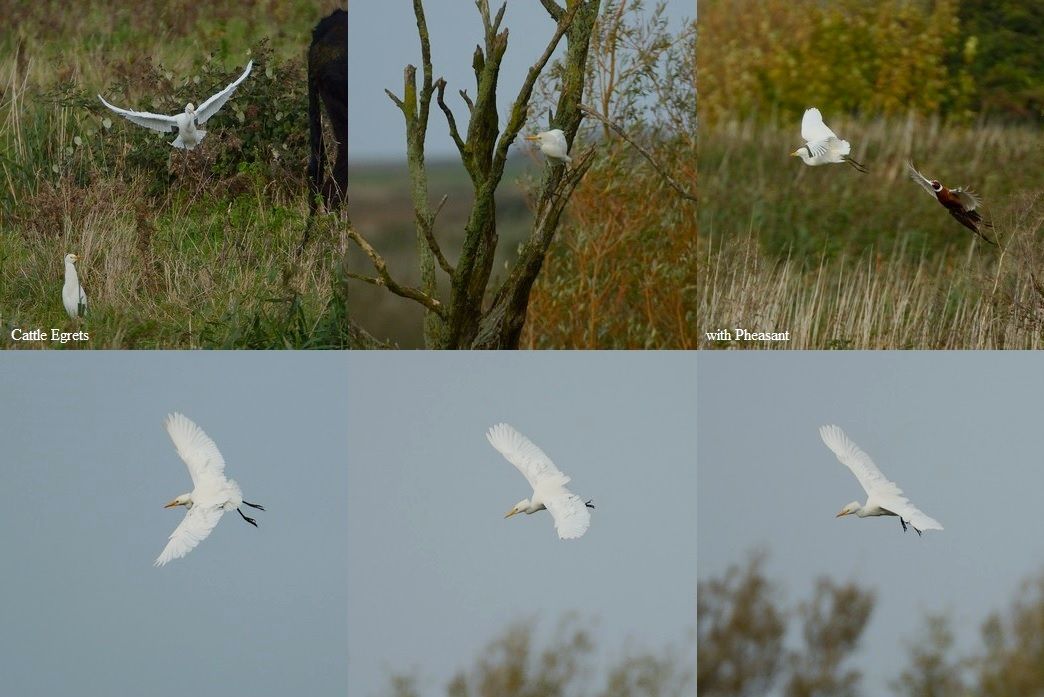
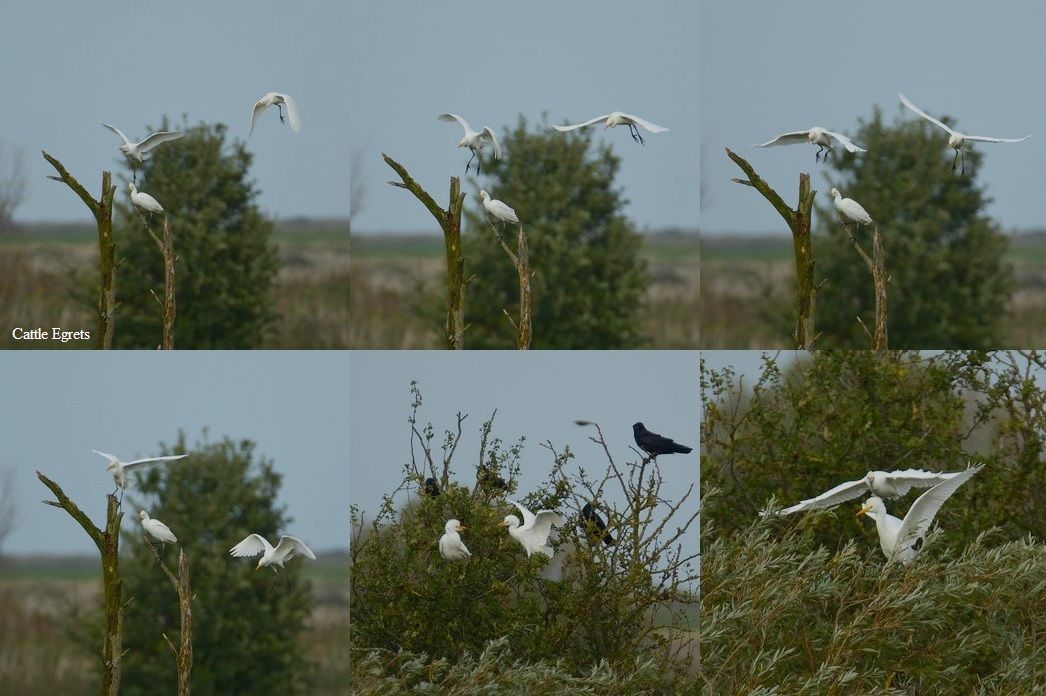
May 2025
More indoor Bee emergences, Muntjac by the garden gate and GYBC defy 'No Mow May!
The first 3 weeks in May began with 4 more Red Mason Bees emerging from the bee hotel nesting chambers indoors (1st) and a Mediterranean Gull heard outside through the living room open window (2nd).
The closest a Muntjac has been to the garden happened in the early morning (3rd) when one was seen on the grass outside the garden near the back hedge but it then came right outside the garden gate and if the gate had been open, I am pretty sure it may have come in. Whilst browsing is an important part of a wildlife garden via human pruning, cutting etc a real-life browser; in this case a Muntjac, may have not been particularly selective in its herbivorous selection!
2 more Red Mason Bees emerged indoors, a juvenile Blackbird was in the garden and the Robin was sitting tight in the nestbox. The first Swift was in the skies over the garden.
A Great Tit was seen just outside the kitchen window with a beak-full of wool (6th) and it suddenly became apparent where it was getting it from; the wool (padding used for packaging) put under some Sunflower plants on the small outside table to protect them from Slugs and Snails. Obviously, this wool packaging can be used for nest-building birds, but it was originally thought to deter Molluscs, by putting it around the base of plants. I tried this last year around Runner Beans but it didn’t work. However, I have since learnt you are meant to fluff-up the fibres, which Slugs and Snails don’t like.
One Red Mason Bee emerged indoors and the first juvenile Starling was in the garden.
After coping with a saucepan with no handle and a frying-pan which would burn food at the blink of an eye, thus setting off the very stressful and loud smoke alarm I invested in some new cooking ware. However, whilst still thinking of a suitable use for the saucepan, I took the handle off the frying pan and it is now reused as a water bowl and bird bath in the garden!
A Holly Blue was in the garden (9th) and this was followed by a male Orange-tip and a Large White. A Blue Tit was seen with nest-material, juvenile Starlings and Blackbirds were present, a Jackdaw ventured in, 2 Collared Dove, 2 Wood Pigeon, a few House Sparrows, Goldfinch and the pair of Robins were also recorded, whilst a Red Kite was seen from the front of the abode and a Common Buzzard to the south-east.
2 Swift were seen (10th) and 1-2 Common Buzzards were also in the skies. A Blue Tit was seen with nest material again and a Holly Blue was also seen.
A Cuckoo heard singing from somewhere to the East (11th) was only the second ever record from the property (2018-present). A Common Buzzard soared over and 4 Swift were in the skies.
A Robin was still sitting in the nestbox and one of the pair (male?) was seen passing food to the other (female?). 2 Blue Tit were present and 2 Orange-vented Mason Bees Osmia leaiana emerged from the bee hotel nesting chambers.
The first 2 Swallows seen from here passed by (12th), as did a Common Buzzard and a Holly Blue was in the garden. A further Orange-vented Mason Bee emerged indoors.
So much for ‘NO MOW MAY’ AS Great Yarmouth Borough Council came to exterminate the flowers and grasses (although they will mow around Daffodils or any other cultivated-looking flower they have knowledge of growing in the grass!) as they usually do, all in the name of so-called tidiness, but the aftermath of what this council does is far from tidy and is a mess at best!
I have complained and even suggested ways to benefit biodiversity and save money in the process to the council for council-owned areas of grass but they take no notice. I am either told ‘sorry you don’t like our cutting regime’ or from one of their councillors (who was pointed out by Extinction Rebellion as someone to get in contact with about GYBC’s attitude to climate change) told me that my opinion was just one opinion.
Am I the only one who has made an effort to get their misuse of land stopped or is it the case I am greatly outnumbered by the ‘tidy people’ who insist on grass being cut in the Great Yarmouth Borough Council’s administrated area?!
Two recently fledged Dunnocks were present (18th) and a Goldfinch also visited the garden.
Two Sparrowhawks were circling around to the east (19th), 4 Swift were overhead and a Holly Blue continued its presence in the garden.
The first Bombus hypnorum Tree Bumblebee queen was seen on the Cotoneaster (20th) and the first Megachile Leafcutter emerged from the bee hotel tubes indoors. 2 Goldfinches continued to visit the garden, mainly to drink from the pond and a Large White flew over and there are now two orange sphere flowers on the Buddleia globosa. In the skies were a single Swift and then a House Martin and a male Marsh Harrier flew south.
2 Swift were overhead (21st) and 2 Goldfinch were again in the garden.
Below: L-R; Top to Bottom: Stock Dove, Jackdaw and Goldfinches.
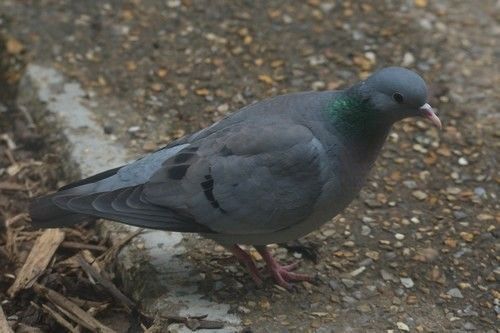
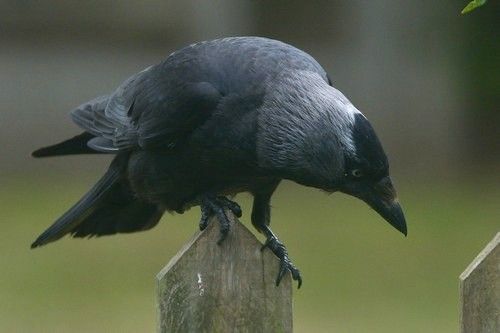
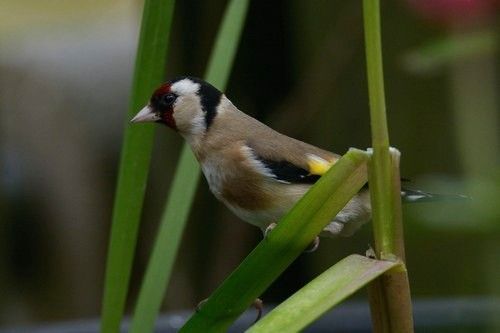
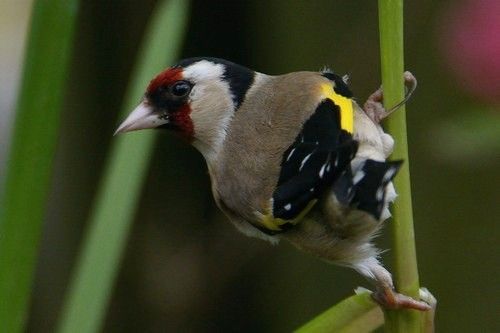
First Swifts, Terns and Wall Butterflies......
The 1st May, out with Jason Nichols headed towards North West Norfolk in view of looking for some interesting light morph Lizards. However, due to the traffic and the increasing temperatures this was put on hold for another time.
So, we started off looking around Choosley Barns where we saw at least 5 Red Kites and 3 Common Buzzards. Both Lesser and Common Whitethroats were heard singing and at least 5 Brown Hares were seen.
Along the road at Titchwell we saw our first 2 Swifts of the Year before we had lunch at Brancaster Staithe.
Here along the channel we saw our first Common Terns of the year (although they had been present in other places before today). There were at least two, maybe more as they joined a number of Black-headed Gulls in a ‘feeding frenzy’ in the channel. Grey Plover, Turnstone and Oystercatchers were also seen with a few Brent Geese still around too.
Swallows mostly in pairs were seen on the telegraph wires at various places, including Holkham before arriving at Wells Pools.
Not too much to report from the pools so we continued to Cley where along Beach Road we found 3 Wheatears on the Eye Field.
A walk along the Iron Road at Salthouse saw our first Wall Butterflies of the year with 3 seen along the path. A Great White Egret was also here and similar to last week so was a Little Egret.
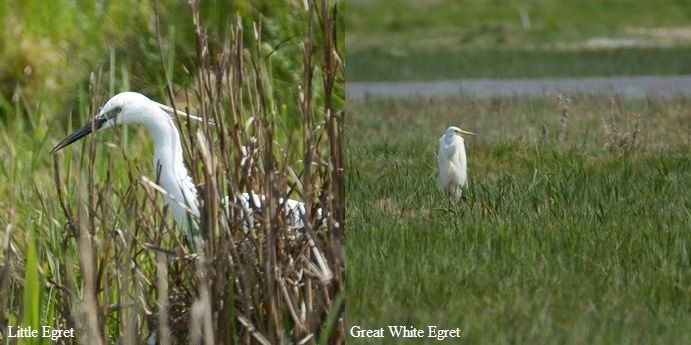
April 2025
Red Masons, signs of Hedgehog and at last some Butterflies!
Red Mason Bees continued to emerge indoors during the last week or so of April, beginning with 3 (23rd). A Robin was holding territory in the garden and both Great and Blue Tits were present. A Common Mourning Bee was seen again but only 2 female Anthophora plumipes aka Hairy-footed Flower Bees were present. A queen Red-tailed Bumblebee was again seen entering the nestbox.
4 Red Mason Bees emerged indoors (24th) and a juvenile Dunnock was once again in the garden.
3 Red Mason Bees emerged (25th), a cock Pheasant flew into the garden off the roof, a Marsh Harrier flew over and a Tawny Mining Bee was found dormant in some Lavender in the cooler temperatures of the late afternoon.
Red Mason emergences continued with 3(26th) and the cock Pheasant were again in the garden as was a juvenile Blackbird.
Hedgehog droppings were found (27th); a good sign and a few Butterflies were good to see for pretty much the first time in the garden this year. A Red Admiral was the first to appear, followed by 2 Holly Blue, Small White and then a male Orange-tip. 2 Common Mourning Bees were entering the A. plumipes mud brick holes, Starlings overhead were ‘fly-catching’ and a ‘Footballer’ Hoverfly Helophilus pendulus was in the garden.
A Blue Tit was bringing in ‘soft furnishings (probably hair) to the nest in the nestbox (28th) which I now know to be in the northern-most box of the 3 terraced nestbox, originally meant for House Sparrows. 1-2 Great Tits were also present and still not sure whether they are definitely nesting or not, as the entrance to the nestbox are obscured by Buddleia globosa. Both Robins nesting in the open-front nestbox were seen and presumably a pair of Starlings was seen with food, probably going in to feed nestlings under the roof tiles of No 11, where one had been seen entering previously. A Holly Blue and a ‘white species of butterfly were seen as was a Common Mourning Bee. The first Small Purple and Gold of the year micro moth was seen and meanwhile indoors 3 more Red Mason Bees emerged.
Finally, the first Hirundine was seen from the garden a single House Martin; in fact the first one I have seen anywhere and a Green Woodpecker was heard somewhere at the front of the property. Although it sounded quite close, I could not see it.
One of the nesting Robins chased off a juvenile Dunnock (29th) and a Blue Tit was still bringing in nest material.
2 Holly Blue and the first definite Large White were in the garden, whilst indoors 7 more Red Mason Bees emerged and as usual were given their freedom.
A female Red Mason decided to investigate the pocket of my shorts, whilst sitting outside and then returned later to repeat the process!
A worn male Anthophora plumipes was still present although the mud brick is now lacking any real activity. Early Bumblebees and Red Mason Bees were finding the Borage flowers very much to their liking and indoors there were a further 9 Red Mason emergences.
4 Common Buzzards were in the skies and then 2 Corvids were seen harassing a Red Kite in the distance.
Also still around were a Holly Blue, Dark-edged Bee-fly and a Common Mourning Bee.
Wheatears, Sedge Warblers and finally the American Wigeon......
A Sedge Warbler singing was the bird of note along Beach Road, Salthouse (24th) whilst out with Jason Nichols.
A look for the reported American Wigeon further up the road, opposite the Dun Cow PH and along the Iron Road was not successful but a Great White Egret in flight along with Skylark and Oystercatchers brought on a spot of photography. Also here were a Little Ringed Plover, Reed and Cetti’s Warblers.
Two Wheatears were found on the Eye Field, Cley and a couple of Swallows flew past.
A look for a pair of Garganey, reported the previous day was not successful, but 2 Whimbrel were good to see, along with 6 Avocet, 70+ Brent Geese, 2 Swallows and both Mediterranean Gull and Reed Warbler heard.
Brancaster Staithe was very light on birds but 15 Turnstone and an Avocet were of note.
The drive around Choosley found two of Common Buzzard and Red Kite, Yellowhammer, 6 Brown Hare, Chinese Water Deer and Jase heard a distant Cuckoo.
Back to Salthouse and despite no one else looking, eventually Jason found the drake American Wigeon with his scope amidst a few Eurasian Wigeon. A Little Egret flew up close by.
En-route we also saw Holly Blue, Orange-tip, more Common Buzzards and Red Kites and the RTA Badger (seen 17th) was still on the verge near Sutton Staithe; a large individual so probably a Boar.



Bees and nesting birds in the garden and the Red Masons move indoors!
The second half of April began with two Goldfinches coming to drink at the pond (14th); always pretty birds to see and 2 Blue Tits were again present with one bringing in some ‘soft’ nest material, indicating the nest in one of the nestboxes is near to completion. A Red Kite was in the skies and this was followed by a Common Buzzard and the first Tawny Mining Bee Andrena fulva of the year was seen on a Flowering Currant.
I had been pondering for some time how to allow the solitary bees to exit the drilled blocks and canes in the bee hotel, without letting them use the same holes again, as I wanted to renew the nesting holes. So, I came up with the idea of bringing the blocks and canes into the lounge in a cardboard box, where I could assist them out into the garden, whilst there would be no bees able to re-nest in the blocks and tubes.
Obviously a fairly constant vigil is needed for this, as they need to find food quickly after emerging, after consuming the provisioned food in the nest chamber. The first Red Mason Bee emerged on the same day (15th) I brought the nest sites in.
Similar to 2024 a somewhat early juvenile Dunnock was in the garden with both parents (presumably?!). A Robin made an appearance for the first time in a while and Blue Tits were ‘feeding on’ parts of the Flowering Currant flowers. Back in 1999, whilst undertaking my dissertation for my degree (on Blue and Great Tit feeding preferences) I came across a scientific paper mentioning Blue Tits feeding on nectar from flowers! This is something I have seen them doing before, on more than one occasion.
Meanwhile, in the lounge 8 Red Mason Bees emerged and were taken out into the garden.
14 Red Mason Bees emerged (16th) followed by another 14 (17th), 13 (18th) and 10 (19th) when there was also a cock Pheasant in the garden again.
A Robin was noticeable by its continued presence in the garden (20th) and a further 5 Red Mason Bees emerged from indoors.
As suspected the recent presence of Robins in the garden brought about nest material being brought in (21st) to the open-front nestbox outside the bathroom, where they have nested before. A Goldfinch and a Blue Tit were of note, whilst in the lounge, the emergence of Red Mason Bees continued with 16 emerging.
Further Red Mason Bee emergences continued (22nd) with a total of 18 emerging from the drilled blocks and canes. It has been essential to keep a look out for them in all areas of my abode and today I found 2 males fighting on the bathroom windowsill, whilst others have been found in the hall and in the kitchen, in fact everywhere!
Anthophora plumipes are still busy in the garden with the females particularly attracted to the Borage flowers, as are the Red Mason Bees which were everywhere in the garden today entering the new blocks in the bee hotel and in the Buddleia upturned stump with holes drilled in it (made last year) to make another bee hotel.
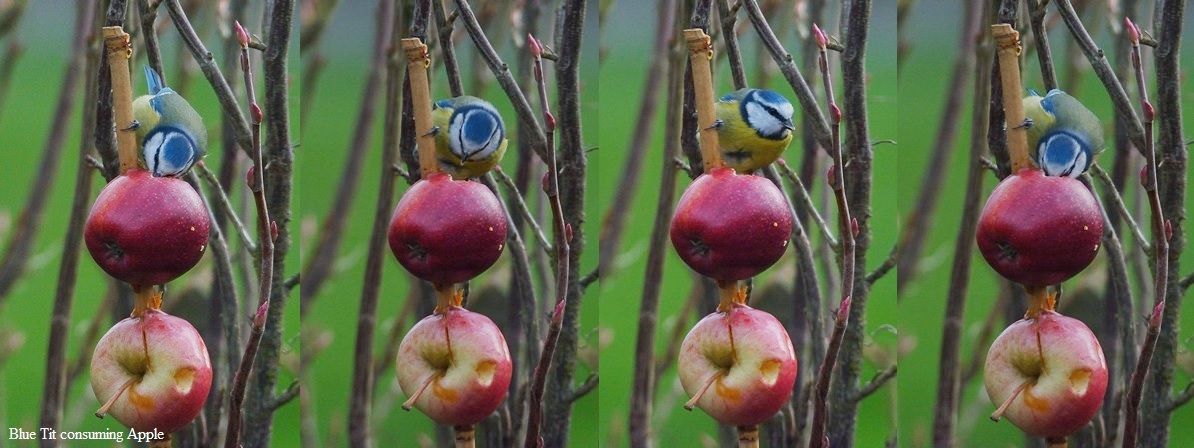
Migrant passerines and first Holly Blues......
The usual journey along the North Norfolk coast with Jason Nichols (17th) began with a Wheatear and 3 singing Sedge Warblers along Beach Road, Salthouse.
Cley’s Eye Field found 4 more Wheatears and 2 Swallows flying through.
The first Holly Blue of the year was seen along the track to Wells Pools and a pair of Grey Partridges was seen again along with Black-tailed Godwits, Avocets and 2 Marsh Harrier.
Brancaster Staithe was rather quiet; bird-wise but a Little Egret and several Black-tailed Godwits were of note.
A drive around Choosley Barns found our first Lesser Whitethroat; not only heard but seen singing from the top of a hedgerow. A Common Whitethroat was also heard but not seen this time and 2 Yellowhammer and a Reed Bunting were of note as were 2 Brown Hare and 2 Chinese Water Deer.
A drive around Salthouse Heath accessed our first singing Willow Warbler of the year, albeit distant. A Blackcap was also heard and another Holly Blue was seen as were 3 Red Kites together.
At Potter Heigham Marshes the first Reed Warbler of the year was heard singing and Sedge and Cetti’s Warblers were also heard. Pair of Marsh Harriers and a Common Buzzard was recorded, whilst there was a good scattering of Peacock butterflies and a Mallard brood.
Finally, entering Martham village a Red Kite was in the skies.
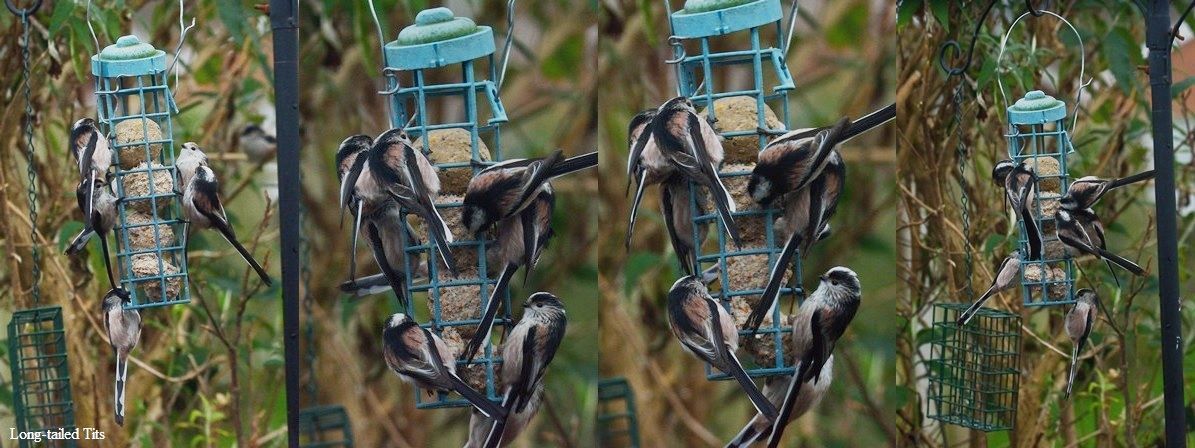

Muntjac, Birds and Bees......
The second week of April opened with a Muntjac near the back hedge on the grass (8th). Although outside the garden this is the nearest one has been to the garden.
A cock Pheasant was in the garden (9th) and also a female Reed Bunting, but no sign of a male since the 7th.

The first Red Mason Bee Osmia bicornis was seen (11th) and later one was seen investigating the new blocks with holes drilled in them in the Bee-hotel.
A possible Green-veined White was seen outside the garden, whilst 2 Dunnock, pair Collared Dove collecting nest material (via some intended untidy gardening!), 2 Wood Pigeon, 3 male House Sparrow and a pair of Blue Tits, one of which was carrying a moss-laden beak-full were in the garden.
Later in the afternoon Bees were very much in evidence and along with the population of nesting Anthophora plumipes Hairy-footed Flower Bees and their cleptoparasites Common Mourning Bees (2, one seen entering the mud-brick holes, again), there was a sighting of the first Tawny Mining Bee Andrena fulva visiting the Flowering Currant.
Buffish Mining Bees were again present and 5 species of Bumblebees were recorded: Buff-tailed, White-tailed, Carder, Red-tailed (one, once again entering the middle nestbox) and Early. Tapered Drone flies Eristalis pertinax were patrolling; holding territory over the garden’s vegetation, 3 then 2 Common Buzzards circled overhead and later a pair of Goldfinch were drinking from the bird bath and a Great Tit was heard singing whilst another was in the garden.
A Wren was of note (12th) with the regular Wood Pigeons, Collared Doves, House Sparrows, Starlings, female Blackbird (with hardly any tail) and Dunnocks all coming in for food.
Norfolk Spring Migrants, Raptor-fest and Alexander Bees and Hoverflies......
An uneventful start at Beach Road, Salthouse with Jason Nichols (10th) saw us drive along Beach Road, Cley looking for migrants on the Eye Field. The particular migrants were Wheatears and I found a male, before two additional birds were seen.
At Morston Quay a Great White Egret flew over and its smaller relative the Little Egret was in the channel.

At Wells Pools 5 Brown Hares were good to see and 5 Ruff, 21 Black-tailed Godwit and a Marsh Harrier were also seen. The first singing Sedge Warbler of the year was heard but not seen, as was a Common Whitethroat and a Blackcap and on the way out along the track we found a pair of Grey Partridges.
Lunch at Brancaster Staithe also saw a pair of Avocet (which seem to be getting more frequent here), Little Egret, Curlew, a few Black-tailed Godwits, Turnstone and 2 Oystercatcher.
The drive around Choosley Barns began with a ‘raptor fest’ with at least 6 Red Kite and 6 Common Buzzard in the skies or down on a field, behind which arable work was attracting a flock of Gulls, which included some Mediterranean as the calls dictated.
Common Whitethroat, Chiffchaff and Blackcap were all heard and a female Orange-tip was the first of the year and also seen were Peacock and probable Green-veined White. However, this week only 2 Chinese Water Deer were seen, probably due to the arable farm-work going on with one field, presumably planting potatoes had a veritable ‘convoy’ of Tractors!

A look over Holkham Freshmarsh found at least 7 Spoonbills present alongside Cormorants, with one carrying nest material. 2 Chinese Water Deer were seen as were 2 Barnacle Geese, before further along the road my first Swallow of the year was seen with another on following; this time a male perched on a telegraph wire in the sunshine.
We stopped in the pull-in at the beginning of the track to Wells Pools to look at something on Jason’s phone but soon my attention was drawn to some activity around the Alexander flowers! Here I found several Eristalis tenax Hoverflies and several solitary Bees, which included Andrena dorsata Short-fringed Mining Bee and some male Andrena flavipes Yellow-legged Mining Bees. Also here was the Hoverfly Syritta pipiens.
A male Orange-tip was seen at Stiffkey and another stop at Salthouse found our 4th Wheatear of the day.
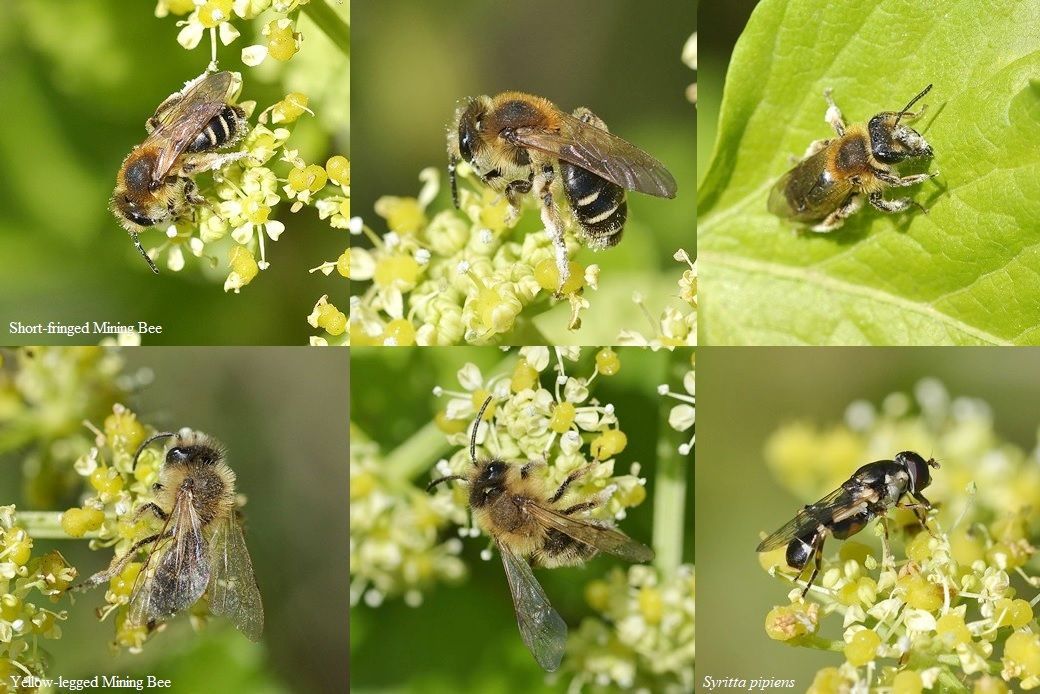
April Beginnings and the first Hedgehog for months-ending up at the Vets!
The beginning of April saw a Common Buzzard overhead being mobbed by Gulls, a cock Pheasant was in the garden and a Blue Tit flew towards the shed nestboxes (1st).
A Blue Tit was again present (2nd) and 2 Great Tits were present with a male heard singing again. The male Reed Bunting reappeared and at approximately 16.30 a young Hedgehog appeared in the garden; the first for many months! It fed under the feeders before coming for a drink at the small bowl, before exiting the garden via the hole cut in the bottom of the gate and making its way towards the far hedge across the grass searching for food as it went.
After returning early from a fieldtrip (which as it happened was fortuitous!) I saw a Hedgehog once again in the garden from the kitchen window (3rd). It was about the same size as the individual yesterday but, it didn’t look very well and very sluggish and laying on its side on the bark path. I picked it up and brought it next to the small drinking bowl, but it just laid there.
I had no regular food for the Hedgehog but suddenly ‘the light went on’ and the sandwich I was making was the answer! So, I went out with a slice of ham pulled into bits and somewhat pleasantly surprised; the hog started eating the ham. I went out again with a further slice of ham and some bits of cheese and it began consuming both food sources. However, it lay down again and I knew I had to do something more drastic so I telephoned Caister Vets at Rollesby and they said when asked, that they would take the Hedgehog in, so it was taken there and I hope I had done enough to give this endangered endemic British mammal a fighting chance!
A male Reed Bunting was again present and later seen fly-catching from the back tree. A Blue tit was present again and the first White-tailed Bumblebee Bombus lucorum of the year was seen around the Flowering Currant.
The male Reed Bunting continued to be seen (4th) and a Blue Tit was once again seen flying to the shed nestboxes and a Great Tit was again present. A Green Woodpecker was heard from somewhere to the south and some sudden ‘squawking’ revealed a Sparrowhawk in the top of the back hedge with a Starling!
A queen White-tailed Bumblebee was in the garden, as was a Dark-edged Bee-fly (5th). The male Reed Bunting remained and a Blue Tit and 2 Great Tits were seen.
Blue Tit nesting was confirmed (6th) with a Blue Tit with a beak full of Moss, which it took to the shed nestbox ‘complex’. 2 possibly 3 Great Tits were seen as were the male Reed Bunting, Dunnock and another Red-tailed Bumblebee.
The nesting Anthophora plumipes in the mud brick (which for the third year has been fantastic to watch with a constant hum of bees coming into the living room through the open window) had a visitor today (7th), which I was expecting; their cleptoparasite a female Common Mourning Bee Melecta albifrons which, was almost systematically going in and out of the mud-brick holes! Every garden should have a Hairy Flower Bee A. plumipes mud brick! See how to make a mud brick and learn about the fantastic A. plumipes on the Wildlife Articles.
The male Reed Bunting was still present (an unprecedented length of sightings and numbers) and the first Red Kites of the year were high in the sky with 3 raptors; one veering off east and the other 2 heading west. A Dark-edged Bee-fly and 3 species of Bumblebees were seen: Red-tailed, Buff-tailed and Early.
A Muntjac was seen from the kitchen window this morning (8th); quite confiding but also still very wary. This is the closest one seen to the garden.
A queen Red-tailed Bumblebee entered the hole of one of the shed nestboxes and was in there for about 10 minutes. Later just before 17.00 it was bath time in the garden with 4 Starling and 2 Blue Tits using the facilities. Also present were a Dunnock, Wood Pigeon and 2 male House Sparrows. It has been noticeable over at least the past 2 weeks that House Sparrows are infrequent visitors and their numbers appear to have decreased!
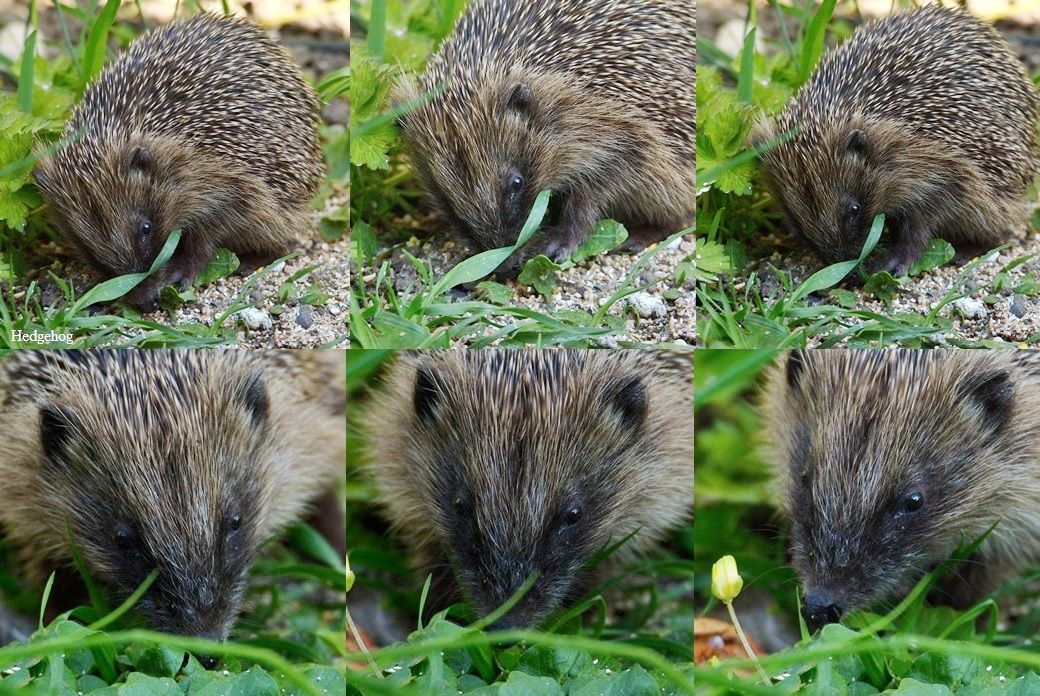

Cranes along the East Norfolk Coast.....
It was a shorter tour of duty with Jason Nichols today (3rd) because Jase had to get back just after midday for an appointment in the afternoon. However, an enjoyable trip up Norfolk’s East Coast began at Somerton.
Pulling in off the road we could see 2 Marsh Harriers over the reeds and in the middle of the field surrounded by Mute Swans was a Black Swan, which we hadn’t seen this exotic escape for some time. At least 7 Pink-footed Geese were also on the field with Grey-lag and Canada Geese and a Cetti’s Warbler was heard and watched for some considerable time as it made its way through the hedge on the other side of the road.
I then saw a Crane flying over the reedbed; one followed by two more (possibly a pair and a juvenile they were trying to part with). Another 2 presumably a pair followed and then 7 Cranes flew past and landed out of sight.
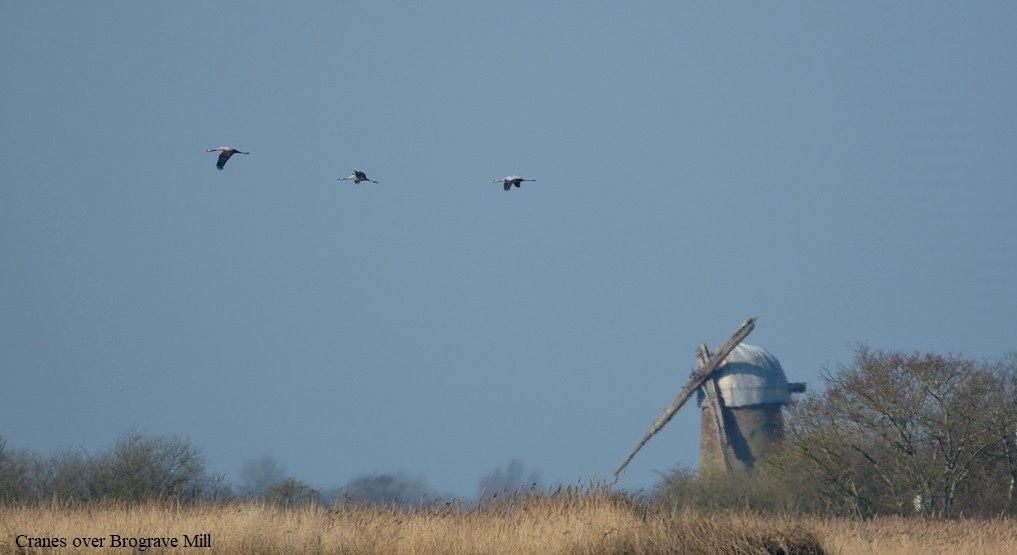
2 Brown Hares were seen at Waxham, with one speeding like a bullet between the furrows of winter wheat!
Common Buzzards were seen en-route before finally, at Walcott we saw several Turnstones fly past but very little else. However, there was drama to come in my garden when I arrived back.
March 2025
The Garden begins to come to life: 26th-31st
The last few days of March saw a pair of Pheasants once again in the garden along with 3 male Reed Buntings, one of which was getting territorial (26th). The first Peacock of the year appeared briefly and a Dunnock and a Buff-tailed Bumblebee Queen were also seen.
A male Reed Bunting was once again present on both 27th and 28th and the next day (29th) saw the appearance of the first Dark-edged Bee-fly Bombylius major and Early Bumblebee Bombus pratorum. Two male Reed Bunting were again present as was a hen Pheasant and the first female Anthophora plumipes was seen. A ‘pair’ of Great Tits gave hope that they would breed again and the male was singing in the garden.
The first Red-tailed Bumblebee Bombus lapidarius was seen (31st) as was a Carder Bumblebee Bombus pascuorum, both male and female Anthophora plumipes were very busy in the garden, especially around the mud-brick and 2 male Reed Buntings continued their presence.
Chinese Choosley!
There was little of interest at either Beach Roads at Salthouse and Cley at the start of the day out with Jason Nichols (27th) so we travelled to Morston Quay.
Black Redstarts had been reported amongst the boats at Morston, but not today! However, a Greenshank was again present along with several Redshanks, Little Egret and a few Brent Geese.
20+ Curlew and a Muntjac were the highlights at Wells Pools and a Grey Plover and several Black-tailed Godwit were worthy of mention at Brancaster Staithe.
Not too much to report from Thornham so off on the drive around at Choosley Barns, where we saw a new record for Chinese Water Deer-21! Several Brown Hares added to the mammal fauna. Red Kite and Common Buzzards were present as was a Yellowhammer.

The A149 pull-in AT Burnham Overy provided us with a Great White Egret and at least 8 Spoonbills and a Muntjac were seen at Holkham Freshmarsh.
A visit to the middle hides at Cley ended the day with a dark Common Buzzard, Black-tailed Godwits, Avocets, Ruff, Common Snipe and a Little Ringed Plover all seen but only sounds coming from the Common Toads in the dyke.
Lesser White-fronts, 'White birds' and Toads!
As usual the day (20th) with Jason began at Beach Road, Salthouse after seeing a couple of Common Buzzards en-route. Not too much here but a Red Kite and a handsome male Reed Bunting were noteworthy, although at the moment I am seeing male Reed Buntings in my garden!
Hearing that the Swedish introduced Lesser White-fronted Geese were visible from the middle hides at Cley, we headed there.
From the car park we saw a Spoonbill and 2 Great White Egrets fly over in an easterly direction before setting out for the hides. Sure enough ‘the 9’ (sounds like Lord of the Rings!) were there on the far bank and good to see too.
Another Great White Egret was seen as it flew up from the far reeds and waders here were several Ruffs, 40 plus Dunlin, Avocet and a drake Pintail.
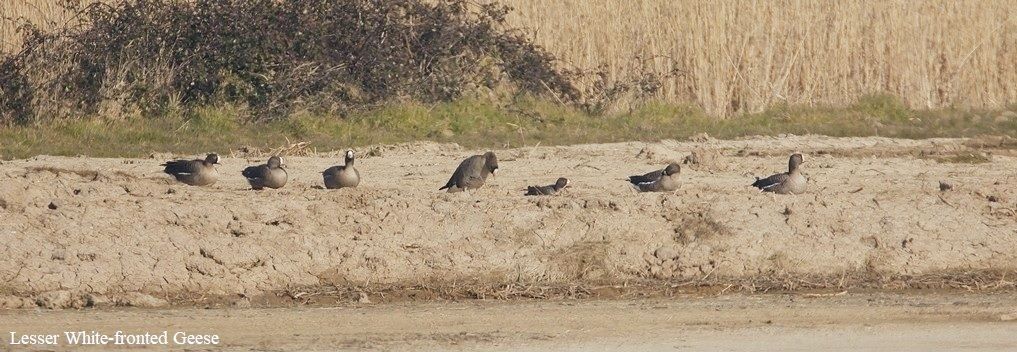


On the walk back as we crossed the bridge over the dyke system we heard the sounds of amphibians. It took a little while before we got a fix on one of several Common Toads, but then we began to see more, including one or two that swam into the open; satisfying our photographic wants!
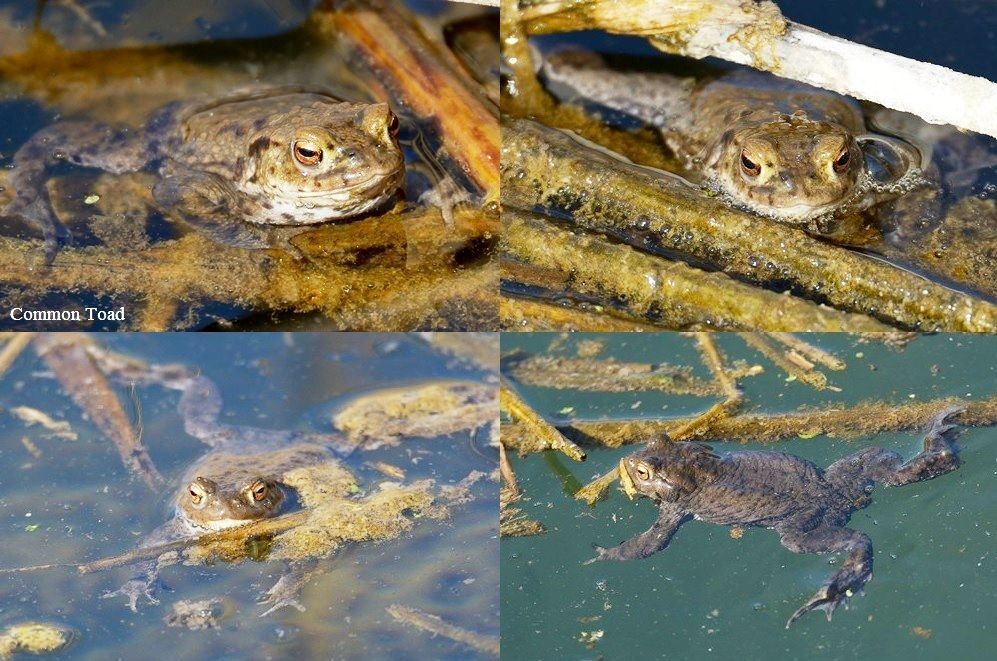
A few Brents were on the Eye Field, Cley but the sea off Coastguards was pretty non-eventful, as was a visit to Morston where 5-6 Redshanks and a Red Kite had to suffice.
Male Brimstone was seen on the way down to Wells Pools where there were 10 Ruff including a satellite male, 2 Common Buzzard, Marsh Harrier and 6 Brown Hares.
Brancaster Staithe for lunch found a few waders with 2 Avocet, 2 Ringed Plover, and 3 Grey Plover, 2 Black-tailed Godwit, Oystercatcher, Turnstone and Curlew, Little Egret and a Spoonbill flew over.
A drive around ‘the block’ at Choosley set a new record for Chinese Water Deer with 11 seen. Several Brown Hares were here too, along with Red Kite, Marsh Harrier, Common Buzzard and several Yellowhammers.
Another male Brimstone was recorded just before Burnham Norton and a Great White Egret was seen from the pull-in along the A149 at Burnham Overy.
4 Spoonbill were seen from the ‘gate’ at Holkham, ending an interesting day but with the Toads being the highlight.
Solitary Bees, Gamebirds, Reed Bunting population rises in the second half of March in the Wildlife Garden......
The second half of March began with a hen Pheasant in the garden (15th), whilst the cock bird stayed outside. A male Reed Bunting was seen the following day (16th).
3 Male Reed Buntings were in the garden (17th), which was amazing to see but this number was increased (19th) when there were 4 male Reed Buntings together in the garden. A cock Pheasant was also present and the first male Anthophora plumipes Hairy footed Flower Bee and the first Andrena nigroaenea Buffish Mining Bee was seen, along with a Wren.
A male Reed Bunting was once again present (20th) along with 2 each of Blue and Great Tits; hopefully a good sign for nesting!
A Red-legged Partridge flew in onto the area of grass outside the back of the garden (21st), not a first but a seldom seen species here; unfortunately it didn’t follow the pair of Pheasants into the garden! A Great Tit was heard singing somewhere outside the garden and a male Reed Bunting was once again present. Sorting out my compost regime found a House Mouse in the compost bin and safely got out.
2 Male Reed Bunting were in the garden (22nd) but now territoriality had begun with one chasing off the other. A Wren was again present, as was Great Tit, 2 Blue Tit, 2 Blackbird, 3 Wood Pigeon and a Dunnock, whilst the cock Pheasant stayed at the back of the garden.
The cock Pheasant was giving chase to the hen bird in the garden (23rd) but the hen exited via the Hedgehog holes cut out in the garden gate! A Wren was seen along with 1-2 Great Tits and yet again the unprecedented presence of Reed Buntings adorned the garden with 3 males present, but one chasing the others off. The Anthophora plumipes males (4+) were busy around the mud brick, no doubt waiting for a female to emerge and exact mating. Buffish Mining Bees were also seen and a queen Buff-tailed Bumblebee was good to see in the garden.
The Reed Bunting presence continued (24th) with what looks like a female either adult or 1stW female new to the population and was soon joined by 2 males. Later 3 male Reed Bunting were present together before the territoriality began again, with one bird chased away but one seemingly tolerated! The pair of Pheasants was in the garden again and my purposely left stems of plants on the bark path were collected for nest material by a Wood Pigeon, which flew off with a beak-full.

Assassin in the garden, Pheasants and Reed Bunting numbers increase......
The first half of March had some interesting sightings in the garden, beginning with a male Reed Bunting (1st), when there was also a Robin, Dunnock, 5 Starling 3 Wood Pigeon and 2 Collared Dove.
A male Reed Bunting was again present 4th and 5th and again on the 8th. The 8th also saw a female Sparrowhawk present. After coming in from the garden; I was in the kitchen when I heard squealing noises coming from outside. On looking out of the kitchen window I saw a female Sparrowhawk just behind the iron border trim shielding a kill. Although I couldn’t actually see what the hawk had caught it was clear from the sounds it was a Starling. The Sparrowhawk began plucking the starling, which was still alive. One of nature’s more uncomfortable situations, but Sparrowhawks do not share human views of what is acceptable and what is not they have evolved to survive in what is a tough world!

After hearing a cock Pheasant somewhere outside the garden both a cock and a hen were actually in the garden, with the male taking a drink from the pond (11th).
Not one but two male Reed Buntings were together in the garden (13th) and a queen Bombus terrestris Buff-tailed Bumblebee was outside the lounge window.

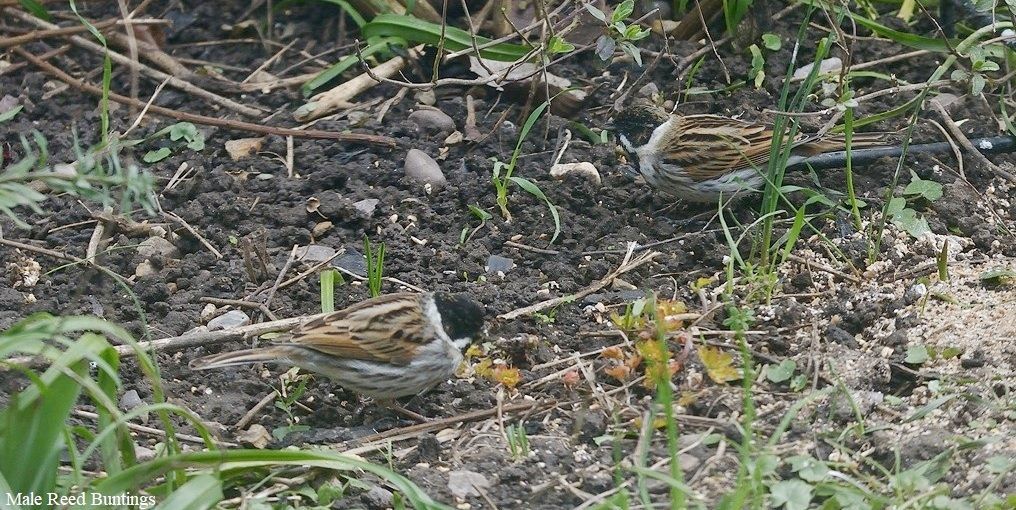
Raptors and first Spring Butterflies......
4 Red Kite, male Stonechat and Curlews started the day (6th) along Beach Road, Salthouse with Jason Nichols.
Along Beach Road Cley; a Great White Egret was seen as it appeared along a distant dyke, but was later seen flying over west. A Marsh Harrier was also present and a return visit later found a female Stonechat and 800+ Brent Geese (see below).
A Greenshank was once again present at Morston Quay on a pool as the tide was high and a Red Kite flew over.
12+ Avocet were the highlight at Wells Pools and further along the road near Burnham Norton 5 Red Kite were together.
Lunch at Brancaster Staithe found a handful of waders: Black-tailed Godwit, Redshank, Curlew, Turnstone and Oystercatcher and a Marsh Harrier quartered the dunes.
The first butterfly of 2025 was seen when a male Brimstone was seen between Brancaster Staithe and Burnham Norton and another at Holkham, where the first Comma of the year was seen at the ‘gate’. 7 Spoonbills were also seen from here and further along 2 Barnacle Geese and a single Pink-footed Goose was seen; the only Pink-foot we saw all day.
A look for some reported Lesser White-fronted Geese at Cley drew a blank, but the day had been good for ‘large’ raptors with Common Buzzards, Red Kites and Marsh Harriers frequently seen en-route as were Bumblebees; probably Buff-tailed.
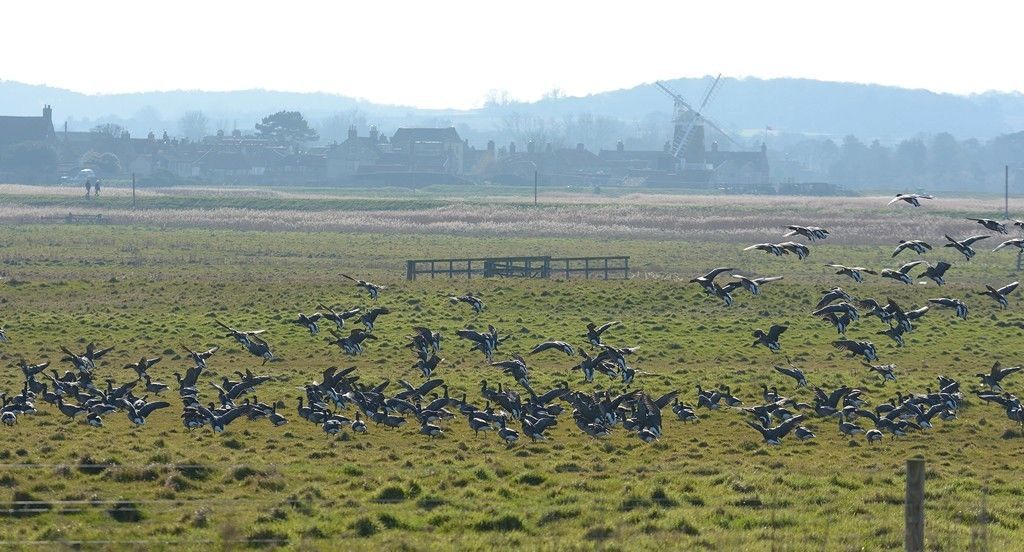
February 2025
February in the garden
During the month, which was mainly pretty cold several species of birds visited the garden. They were: Collared Dove, Wood Pigeon (up to 4), Jackdaw, Blackbird, Robin, House Sparrow, Dunnock, Blue Tit, 2 Great Tit and a Wren was seen three days running looking for food in the foliage.
An immature male Reed Bunting was once again in the garden (24th) and again the following day (25th), when a Wren, 2 Great Tit, Blue Tit, Blackbird, 3 Starling, Robin, 2 Collared Dove and 2 Wood Pigeon were also garden visitors.
The immature male Reed Bunting appeared in the garden once again (26th) when it fed from a seed tray, on the ground, underneath the feeding station and on the fatballs. However, the House Sparrows decided it was not welcome and chased it off.

Day of the Goose, Hat-trick of Egrets and 2 Barn Owls......
Quite a few Lesser White-fronted Geese from a Swedish reintroduction programme had arrived in the UK (mainly Norfolk) and it was this in mind that enticed Jason and I towards North West Norfolk (13th).
There had been a report of 9 Lesser White-fronts at Binham the previous day so we headed there first. No geese here but a lone Cattle Egret was on the grounds of what must have been a very large church at one time, opposite Binham village hall. Further along the road we encountered 2 Red Kites, seemingly following the hedge cutting, maybe hoping for a meal.
We then headed for Warham, where Jason had seen a report of Lesser White-fronts the previous day too, which probably related to the same report I had seen at Binham; confusing!
We parked up near Warham Fort, usually a summer time destination in search of insects and after wandering down the road a bit where through a gap in the hedge we could see geese moving but then retraced our steps and went along the track to the fort and headed towards a fence, where the geese were visible, albeit at distance!
We could see some smaller white-fronts with some Grey-lag Geese and further studies with the telescope revealed them to be Lesser White-fronts. We could see about 6 through a gap in the Juncus of the 9 reported and also present away from the Lesser White-fronts and Grey-lags were White-fronted Geese and Barnacle Geese. A Red Kite and a Little Egret were also seen here.
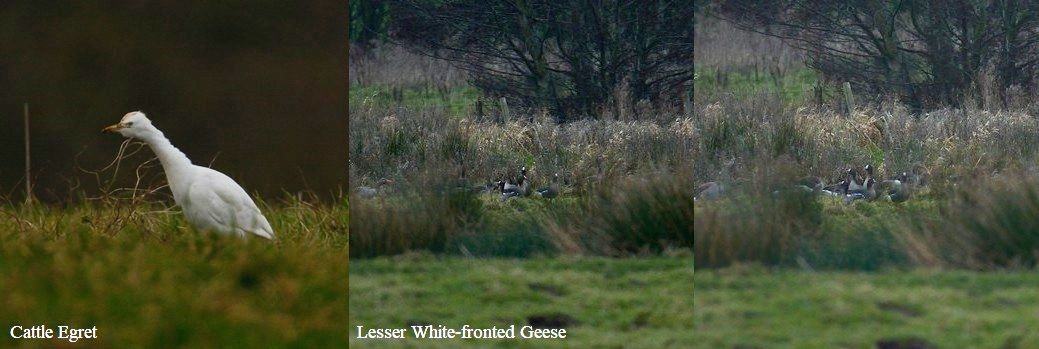
We then had a look at Burnham Overy Staithe and found a selection of waders, which included: 3 Ringed Plover, Grey Plover, Redshank, Curlew, Oystercatcher, 2 Dunlin and also a Little Egret.
Lunch at Brancaster Staithe didn’t really find too much to begin with but Jason spotted 3 Red-breasted Mergansers at the far end of the eastern channel, which then promptly flew off! Also here of note were Ringed Plover, Curlew, Turnstone and Oystercatcher.
A drive around ‘the block’ at Choosley Barns found quite a good variety of wildlife with 10 Chinese Water Deer being a record here where once there were none!
Several Brown Hares were also seen and predators included Red Kite and Common Buzzard. At least 11 Fieldfare were on a stubble field with a Song Thrush and in the hedgerows we found at least 2 Reed Bunting, 4+ Yellowhammer and a charm of Chaffinch.
Approximately 1000 Pink-footed Geese were in the skies, seemingly looking for somewhere to land but even when they did they were not there for long-very skittish!
Just before arriving at the A149 pull-in at Burnham Overy a Barn Owl was spotted (by Jason) on a post, It wasn’t there for long but then hunted along the hedgerows until lost from sight.
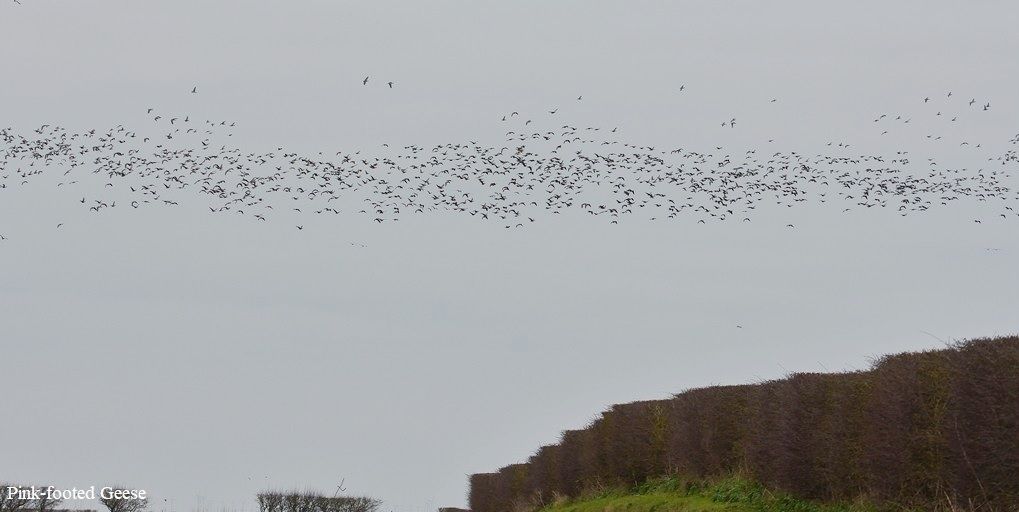
2 Great White Egrets were seen on Holkham Freshmarsh and 70+ Barnacle Geese were there too.
Another Barn Owl was seen out hunting and perching on posts at the back of Wells Pools and 2 Avocet were of note here too.
Further along, between Wells and Stiffkey we came across at least 1000 Brent Geese on a field and also here were Curlews and 4 Brown Hare.
A Greenshank was the highlight at Morston Quay and at Cley Coastguards a raft of Common Scoter was still present and a Little Grebe was on the river along Beach Road. Finally more Geese with 70+ Brent Geese on a field at Salthouse; definitely ‘day of the goose’ plus other highlights.
When Nature can't be 'pigeon-holed'?
The first birds of note, out with Jason Nichols (6th) were 400+ Common Scoter off Cley Coastguards, but apart from a Black-headed Gull nothing else was found in their midst.
Morston Quay yielded a Greenshank but very little else and only Brent Geese were of note at Wells Pools.
Lunch at Brancaster Staithe found 3 Ringed Plover, Grey Plover, Redshank, 11+ Turnstone (enticed by some food), Curlew, 2 Black-tailed Godwit and Oystercatcher, plus a couple of Common Gulls.


The approach road to Thornham Point saw a Song Thrush fly across the road but very little else at Thornham Harbour, where both Glaucous Gull and Black Brant had been reported, but venturing out on a walk in very cold conditions to find any of these was not justified!
Choosley found raptors: Marsh Harrier, Common Buzzard and Red Kite and smaller species seen were 11 Yellowhammers. Mammals-wise we saw 6 Chinese Water Deer and at least 2 Brown Hare.
Stopping off at the pull-in along the A149 overlooking Burnham Overy Marshes only found some Pink-footed Geese, whilst at Stiffkey, now the thaw had occurred the Glossy Ibis was now sighted, despite its absence on the drive through.
We stopped at Walsey Hills where a Siberian Chiffchaff had been reported, over several days. Whilst in the car I heard a song that I didn’t recognise. It had in it phrases of a Dunnock and Robin I thought but later after listening to several recordings of Siberian Chiffchaff, the song I had heard seemed to fit the brief.
We walked to the eastern side of Walsey Hills where the Chiffchaff had been reported from and after about quarter of an hour we began to see movement, which up until now had been a bird-less area. We saw several Goldcrests and Chiffchaff, maybe more than one.
Later, on researching Siberian Chiffchaff I found very clear cut criteria, which were considered necessary to verify this subspecies, but the photographs contained therewith contradicted the criteria set out!
Both Jase and I looked at our resultant images and considered some of the images taken to fit the description of this bird, but the literature regarding this subspecies (species considered by some!) covered some very variable forms of what is regarded as a Siberian Chiffchaff!
Now maybe there is a subspecies/species here somewhere but with several considered subspecies of Chiffchaff overlapping one and another’s distribution, I wonder what the evolutionary isolating factor is here?
Not too long nothing would be considered by science as a species unless it was isolated through allopatric speciation (a species isolated by say a sea or mountain range). However, now Sympatric speciation (speciation occurring without physical boundaries but notably attributed to sexual selection, for example Cichlids in Lake Malawi) is accepted it could be that birds are being selected through song or call or both.
I do think this ‘splitting’ and calling a bird a different species is on very shaky ground by the individuals who are judge, jury and executioners and I am afraid I don’t recognise or accept their overall skills to adjudge this.
Whilst evolution can take a very long time to happen via say environmental or genetic mutation (mutation in the majority of cases is usually damaging at best or fatal), evolutionary processes can also happen in a very short time, for example the Geopiza Finches of the Galapagos or the seasonal change in beak morphology found in the Great Tit, but this change can be reversible too!
The genetics of speciation is problematic at best and I for one do not know nearly anywhere enough about it as I would like, but I am not the one sitting on the ‘speciation throne’ deciding something which the ‘birding’ fraternity do not seem equipped to make decisions about. It may be the case that instead of appreciating the processes which affect birds via evolutionary change there seems to be a drive to add numbers to a list, although recent changes by the BBRC have knocked several birds off people’s lists, oh dear!
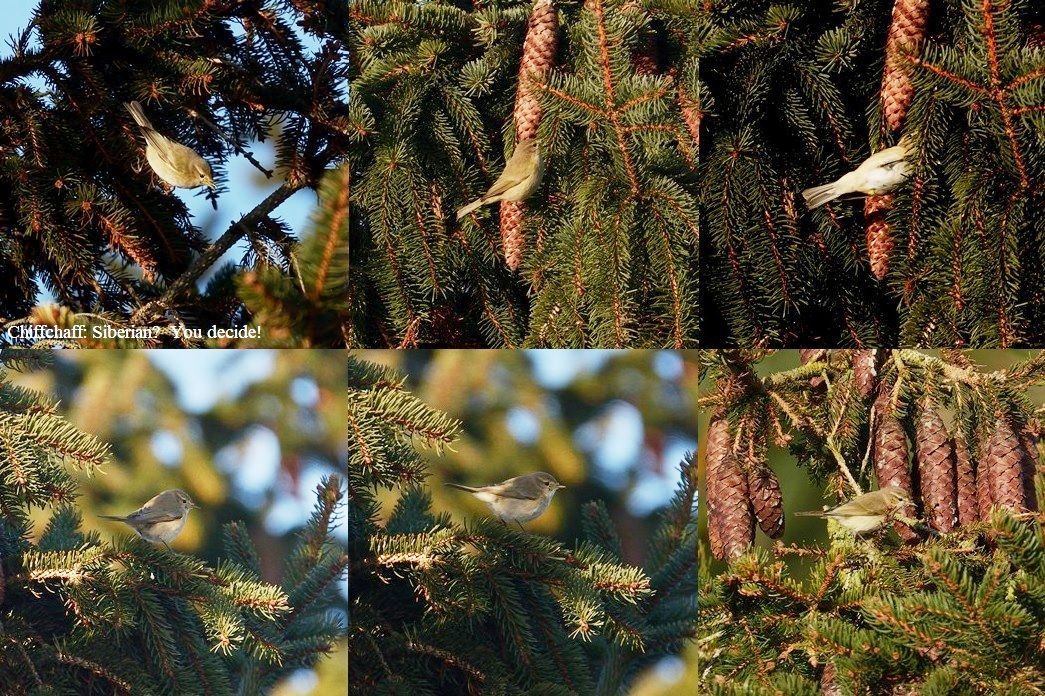

Travelling through Weybourne a Sparrowhawk was taking the same path, hunting along the road; just as woodland edge would be to, it but a dangerous place in modern times!
With a hat-trick of Egrets and lots of Geese both in species and numbers plus two Barn Owls; as a former pupil of Kirmington Primary School who went to school with my kids would say: ‘The jobs a good-un’! (Guy Martin).
Second record of Bunting in 2025......
An immature male Reed Bunting was in the garden (2nd) looking for food below the feeding station. This is the second record of this species this year, which we occasionally get in cold weather.
2 Collared Dove, 2 Wood Pigeon, several House Sparrow, Dunnock, Robin and Blackbird was also seen.